Matador Network's Blog, page 164
May 26, 2024
Lift-Serviced Bike Parks: What to Know Before Your First Visit
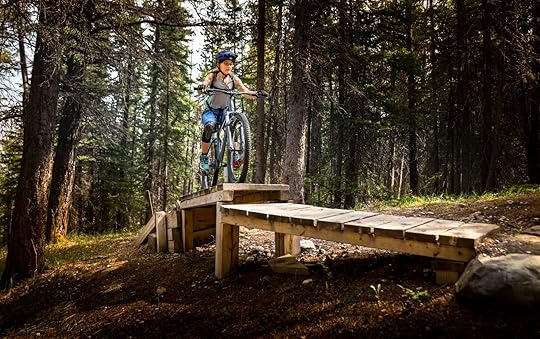
Mountain biking has long been growing in popularity — and ski resorts have long been trying to find ways to stay busy in the warmer summer months. So it’s a natural fit to combine the two, creating mountain bike parks at ski resorts, using the ski lifts to carry riders (and their bikes) to the top.
Lift-serviced mountain bike parks are available at many ski resorts around the world, creating a safe and purpose-built place for bikers of all ability levels to ride multiple trails per day without much uphill pedaling. Advanced riders can save their energy for steep, active downhill lines, and beginners can ride gentle trails multiple times to practice skills and bike control. Trails are meticulously designed and built to specific difficulty levels, making it much easier to know exactly what to expect on each trail. Bike parks also have trail maps, clear signage, and on-mountain staff to make it nearly impossible to get lost.
However, it can be hard to know what to expect if you’ve never been to a lift-serviced bike park before. So whether you’re new to mountain biking or just new to mountain bike parks, here’s the basics of what to expect on your first visit, and how to make the most of your day on the hill.
Jump to:What is a bike park?How much do bike parks cost?What type of bike should you use?What are the trails like?Flow vs. tech vs. cross-country trailsWhat gear to wear at a bike parksHow do bike park lifts work?Are bike parks good for beginners?Passing faster/slower ridersSmall versus big bike parksBig bike parks in North AmericaWhat is a mountain bike park?
Bike parks carry riders (and their bikes) to he tops of trails using ski lifts (or gondolas). Photo: Kristi Blokhin/Shutterstock
There are two kinds of mountain bike parks — lift-serviced parks, like the ones at ski resorts, and smaller neighborhood bike parks, with small jumps and short trails where riders can work on bike skills. But when most people refer to bike parks, they’re talking about lift-serviced parks, usually at ski resorts in the summer.
Unlike traditional mountain biking, where reaching the starting point often involves a significant uphill climb, lift-accessed parks eliminate that part of the experience. Bikes and riders reach the top of the trails on ski resort chairlifts, allowing for multiple downhill laps throughout the day without expending energy on lengthy uphill climbs. Bike parks usually have a network of downhill (and sometimes flatter cross-country) trails made just for mountain bikers — it’s not the same trails you would ski on in the winter.
Almost all bike parks have beginner, intermediate, and advanced trails, as well as trails built just for jumps, drops, and tricks. The trails vary in difficulty, with beginner-friendly options offering gentle slopes and smooth surfaces, while more advanced trails boast steeper inclines, technical features, and challenging obstacles.
How much do bike parks cost?Just like at a ski resort, you’ll pay to use the trail system. Fortunately, it’s not as expensive as skiing, though it can add up. Some of the largest bike parks in North America can get pricey, like Aspen Snowmass Bike Park in Colorado ($83 per day) or Whistler Bike Park in British Columbia ($84 Canadian per day). Smaller parks can often be far more affordable, sometimes as low as $30 per day or so. A season pass can cost anywhere from $300 to $700 or more, depending on the park. Most parks also sell less-expensive half-day or evening passes, as well as bundled multi-day tickets. Often, if you buy your tickets online in advance, you’ll save a few bucks.
What kind of bike do you use?
Bike rental shop in Whistler, BC. Photo: Suzie Dundas
At a downhill bike park, you need to use a full-suspension technical mountain bike. You cannot use a hybrid bike, a road bike, a hard-tail bike, or an inexpensive mountain bike from Target or Walmart. You’ll also want a mountain bike with a lot of suspension in the back so it can absorb bumps and bouncing better.
If you don’t know what any of that means, or don’t have a bike that meets those specifications, you can always rent bikes at the bike park. Renting a bike can be the best way to know you’re on the right type of bike for the trails, and know that the bike is maintained and in good condition. Rentals are usually more expensive that the bike tickets, with major resorts charging rates like $130 (Northstar, CA), $134 (Killington, VT, and Trestle Bike Park, CO), or even $175 (Angel Fire Resort, NM).
If you’re a beginner and plan to only ride very easy flow trails, you can probably use the same full-suspension mountain bike you’d use on your local trails (as long as it’s not a cheap mountain bike from a big box store). If in doubt, call the bike park you’re planning to visit and ask the rental shop what they recommend.
What are the trails like?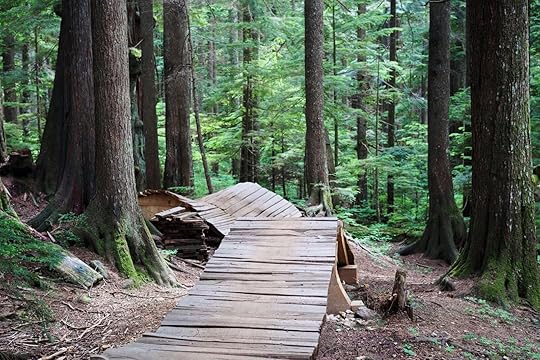
Bike parks often have human-made features like brides and jumps. Photo: sophiecat/Shutterstock
Mountain bike parks run the gamut from steep and technical (filled with lots of obstacles like roots, rocks, and boulders) to smooth and nearly flat. All mountains have trails for every level of rider, and many have beginner zones (for novice riders) and “progression zones,” where riders can safely work on improving their skills. Some bike parks also have cross-country trails, which tend to have more gentle up and down slopes with pedaling, rather than being a steep, all-downhill line.
Just like in the winter, there’s a trail map for every resort. And just like a ski trail map, it shows difficulty ratings, intersections, and everything else you need to find your way around the mountain. Many parks, such as Whistler, have a rating scale, so you can see all the trails in order of difficulty. It’s usually online or printed on the trail map.
Flow vs. tech vs. cross-country trails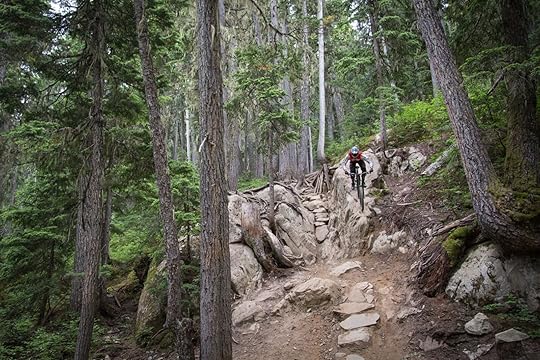
Technical trails have more obstacles and are ridden slower than flow trails. Photo: iestyn_evans/Shutterstock
Most mountain bike parks divide trails into three categories: flow trails, technical trails, and cross-country trails. The easiest trails are marked in green, intermediate trails in blue, difficult trails in black, and very difficult trails in double black. Some parks have red trails, called pro lines. Don’t ride those unless you have professional-level bike skills.
Flow trails are smooth, fast, and offer a sense of continuous momentum. These trails typically have wide, bermed corners that allow riders to maintain speed through turns without excessive braking. They might also have rollers, small jumps, and pump sections that allow riders to generate speed by pumping their bodies up and down in rhythm with the trail features. Flow trails prioritize a fun and fast experience, making them ideal for riders of all skill levels, from beginners looking to build confidence to experienced riders seeking a high-speed descent. While advanced riders can go very fast on flow trails, beginners can use them to practice cornering and getting comfortable at gradually increasing speeds.

Flow trails are smoother than tech trails and meant to be ridden at higher speeds. Photo: Evan Bing
Technical trails are designed to challenge riders with a variety of obstacles and terrain features. They usually have more roots, more rocks, trickier corners that require choosing a more specific path (called a line), and features like wood bridges or stairs. Riders on technical trails will spend more time navigating obstacles with less focus on speed. There are tech trails of every level, but as a very general rule, a green tech trail will be harder than a green flow trail.
Cross-country trails are the least common in lift-accessed bike parks as they typically involve more uphill riding, which goes against the core advantage of a lift system. However, some parks do offer some XC trails for riders who appreciate pedaling. They’re usually fairly natural, without a lot of human-built features like jumps or log bridges. Cross-country trails are not necessarily more leisurely than downhill trails as quite a bit of pedaling is involved, but they’re often longer and not as steep as downhill-oriented tech or flow trails.
What gear do I need, and can I rent it?
Full-face helmets are recommended in bike parks, regardless of your skill level. Photo: Aleksei Potov/Shutterstock
Aside from your bike, the only piece of gear you need is a helmet. Most people wear full-face helmets to bike parks, which are the larger helmets that cover your whole head, with a protective band around your jaw. The second option is to wear a standard bike helmet like you’d wear to bike at home. You can rent helmets at every bike shop, usually included in rental costs. You’ll also need some kind of eye protection, like clear glasses, sunglasses, or goggles. Without this, the wind will make your eyes water as you go downhill.
Gear you don’t need need, but will probably want, includes knee pads, a padded bike short, long shorts that cover your upper thighs, and a shirt that covers your shoulders (to protect your skin if you fall). Tall socks and elbow pads can offer extra protection, too. While you can’t rent clothing at most bike shops, you can rent protective items like knee pads.
You don’t need to have special mountain bike shoes, but you do need a tight athletic shoe of some kind. Shoes with firm, flat bottoms work best, as they’ll help you stay secure and stable on the pedals.
How do you get your bike up and down the mountain?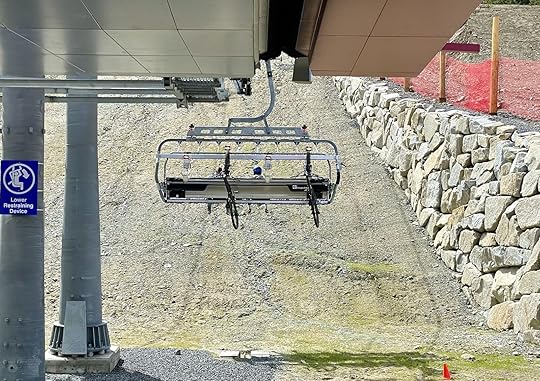
You’ll load your bike onto the lift in front of you, and can always ask the attendants to help. Photo: Suzie Dundas
Loading your bike on and off the chairlifts is usually quite easy. At most parks, chairs alternate between chairs for people and chairs for bikes. When it’s your turn, you roll your bike onto the bike mount in front of you. Once it’s locked, you ride the next chair up (just like a ski lift). On some newer lifts, such as the Fitzsimmons Express at Whistler, people can sit on every chair. Instead of alternating between chairs for bikes and chairs for people, the bikes go on the back of the chair in front of you.
If you’re worried about mounting your bike on the lifts while they’re moving, just ask the lift attendants to help out.
At the top, the lift attendants will take the bike off for you and hold it until you arrive, since you’ll be one chair behind the bikes.
Are bike parks good for beginners?
Bike parks are a great place to practice skills over and over without exhausting yourself on an uphill pedal. Photo: Ramon Cliff/Shutterstock
Bike parks can be a good option for beginners with some important considerations. If you’ve never ridden a mountain bike with shifting gears or a seat that can move up and down, try to rent one for a day before you visit the bike park. It’s not essential, but being familiar with the basics of shifting will reduce your learning curve at the park.
Otherwise, lift-serviced bike parks can be a great place for beginners to learn and progress in a safe and controlled environment — but it’s important to be realistic about your skill level and comfort zone. Starting with a lesson or clinic is a good way to build foundational skills before venturing out on your own. You should always start on an easy trail, since some bike parks are harder than others. Something considered “easy” at Mammoth Mountain in California may be considered “challenging” at the much smaller Chestnut Bike Park in Illinois.

Bike parks are a great place to work on features like jumps and drops. Photo: Evan Bing
However, bike park are a great place to learn. Trails at lift-serviced bike parks are more controlled compared to natural trails. They’re designed for specific skill levels, minimizing unexpected obstacles or hazards that beginners might encounter on natural terrain. And because bike parks have progression charts, it’s harder to get in over your head in terms of difficulty. You also usually have multiple ways to make it back to the bottom, so if you attempt a blue trail and it seems too difficult, you can go back to a green at the next intersection (depending on the mountain).
Bike parks also almost always offer lessons. Beginner packages are also popular, often including a bike rental, lesson, and lift ticket. Good deals around the country for beginners include:
Bolton Valley, VT: $90 gets you a half-day bike rental with protective gear, a half-day lift ticket, and a 90-minute group lesson.Massanutten, VA: A bike rental with safety gear, a three-hour beginner trail pass, and 90-minute group lesson is $95. (Read more about Massanutten.)Thunder Mountain Bike Park, MA: Get a bike park lift ticket, bike rental, helmet/protective gear, and a two-hour lesson for $165.Silver Mountain Resort, Idaho: A package with a two-hour lesson, bike rentals and protective gear, plus an all-day lift ticket is $116.Deer Valley, Utah: A full-day lift ticket, bike rental, and three-hour afternoon bike clinic is $195.What happens if someone is faster/slower than me?
Slower riders have the right of way on beginner and intermediate trails. Photo: Tourism Delta/Tyler Garnham
If you’re worried about having faster riders come up behind you on the trail, don’t be. There are specific rules in place to manage rider interactions, and on easy (green) and intermediate (blue) trails, slower riders have the right of way. That means when someone comes up behind you, they’ll probably yell something friendly like “hi, coming up behind you.” When you find an open spot to pull over (not on the trail), let them pass. If there’s nowhere good to stop, it’s okay — just keep going, and pull over at the next trail intersection.
If you’re nervous, when you’re at the top before you start pedaling, just let anyone else standing around know that you plan on moving slow. Bikers know that everyone rides at different ability levels and are usually happy to give you space. The exception to this is on double-black, red, or pro lines, when it’s expected that you can ride at a somewhat high speed. But otherwise, don’t worry about it. It’s the responsibility of the rider in back to be in control and maintain a safe enough distance.
Small vs. larger bike parks
All bike parks have trails for beginners through advanced riders. Photo: Tourism Whistler/Justa Jeskova
It can be tempting to think that beginner riders should stick to smaller bike parks, but that’s not the case. Large bike parks like Whistler and Mammoth Mountain will always have lots of beginner trails, even if they’re known more for expert-level riding. A smaller bike park that only has 10 trails in total may only have two or three for beginner riders. So it’s more important to look at how many trails a bike park has within your riding level, rather than assuming beginners should stick to small parks or experts can only go to big parks.
However: one thing worth considering is the total elevation of a bike park. If you don’t feel like you’re in physical shape for biking quite yet, you may want to choose a mountain with less elevation gain to make each downhill lap a little shorter. Conversely, if you want longer laps, head to a park with more elevation gain.
Bike parks by sizeSome of the biggest bike parks in North America are:
Whistler Mountain Bike Park in Whistler, BC: 50 miles of trailsMammoth Mountain Bike Park in Mammoth Lakes, CA: 80+ miles of trails (and half beginner/intermediate level)Jackson Hole Bike Park in Jackson Hole, WY: 70+ miles of trailsDeer Valley Resort in Deer Valley, UT: 60+ miles of trailsTrestle Bike Park in Winter Park, CO: 40+ miles of trailsNorthstar California Bike Park in Truckee, CA: 40+ miles of trailsBeaver Creek Bike Park in Beaver Creek, CO: 45+ miles of trailsSchweitzer Mountain in Sandpoint, ID: 40+ miles of trailsBig Sky Resort in Big Sky, Montana: 40+ miles of trailsAngel Fire Bike Park in Angel Fire, NM: 60+ miles of trailsKillington Bike Park in Killington, VT: 30+ miles of trailsGrand Targhee Bike Park in Alta, WY’: 70+ miles of trails More like thisTravel'Mountain of Hell' May Be the Most Extreme Bike Race in the World
More like thisTravel'Mountain of Hell' May Be the Most Extreme Bike Race in the World
May 24, 2024
Airbnb Partners With ChargePoint to Bring EV Chargers to More Rental Properties

Vacation rental site Airbnb and electric vehicle charging station provider ChargePoint this week announced a partnership to make it easier for Airbnb owners to install EV chargers at their properties. The pact between the two arises from increasing demand by Airbnb customers for charging infrastructure – electric vehicles now account for 14 percent of new car purchases globally. Airbnb surpassed 1 millon properties with EV chargers in 2022, and that number is now expected to drastically increase in the coming years.
Electric vehicles are the future of road trips! Just so you know, Matador may collect a small commission from the links on this page if you decide to book a stay.
“With Airbnb, we are enabling more EV charging for drivers where they need it and helping Airbnb hosts appeal to more travelers by delivering a frictionless charging experience for their guests,” said ChargePoint CEO Rick Wilmer in a press release. “Through this partnership, we have created an innovative model to deliver integrated charging solutions and services.”
The deal creates a purchase package for Airbnb owners aimed at ensuring efficiency and affordability when installing a charger from ChargePoint. Airbnb has reported significant growth in search terms for homes with EV chargers, which aligns with EVs increasing automotive market share and continually improved mileage range.
Travelers staying in Airbnb rentals will now more frequently have the option to charge overnight rather than having to find public charging stations, making road trips and other trips much more efficient. Airbnb lists properties with EV chargers in a special page on its site. This move continues to put the misrepresented and overhyped concept of range anxiety to bed for good.
“We are thrilled to join forces with ChargePoint to help Hosts meet growing demand for electric vehicle chargers from guests,” Airbnb’s Director of Sustainability Ameet Konkar said in the press release. “By making it more affordable for Hosts to install EV chargers, we are empowering them to take more sustainable actions and appeal to guests who are interested in this amenity.” 
15 Airbnbs in Las Vegas With a Pool for a Perfect Getaway
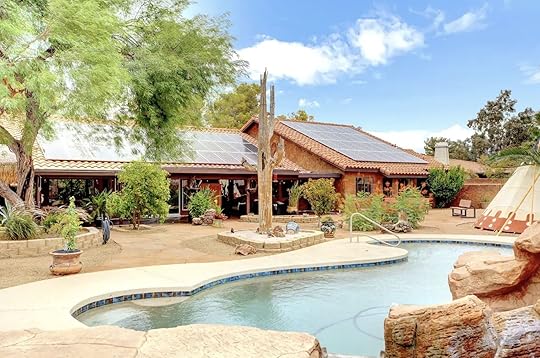
Las Vegas is a city known for its lavish hotels and resorts, but many young and savvy travelers are turning to Airbnbs for more affordable and unique experiences — and Las Vegas certainly has some of the most unique Airbnbs you’ll find in the US.
But there’s one big drawback to Vegas: it can get hot. Really hot. It’s in the Mojave Desert, with an extremely warm and dry climate and very little precipitation. The city experiences very hot summers, and temperatures can easily reach 105 degrees F or higher. That’s why you’ll want to make sure you book an Airbnb in Las Vegas with a pool — and maybe a hot tub, since it can get chilly on winter evenings (well, into the 50s F).
Every listing below is an Airbnb in Las Vegas with a pool, and most are private. Las Vegas tends to be a rather inexpensive city, and you can find rentals below $50 a night, especially if you don’t mind a shared pool.
Traveling to Las Vegas? Check out Matador’s city accommodations guides7 Las Vegas airport hotels for anyone who doesn’t have time to go into the city7 Perfect Las Vegas Airbnbs for an Unforgettable Bachelorette PartyThese Las Vegas Airbnbs Offer the Best Vegas Experience on and Off the StripThe 10 best Airbnbs on the Las Vegas Strip
Skip to:
How far is Las Vegas from the Grand Canyon?How about Vegas to the Hoover Dam?Where to stay in Las VegasWe hope you love the spaces and stays we recommend! Just so you know, Matador may collect a small commission from the links on this page if you decide to book a stay. Listed prices are accurate as of the time of publication.
MGM Grand Signature Studio Photo: Airbnb
Photo: Airbnb Photo: Airbnb
Photo: Airbnb Photo: Airbnb
Photo: Airbnb Photo: Airbnb
Photo: AirbnbThis rental is a one-bedroom suite on the Las Vegas Strip at the MGM Grand. Guests have full access to MGM Grand Signature amenities, including a massive outdoor pool area with a jacuzzi and concierge services seven days a week. It’s a studio unit, but a very big one, and the bathroom is nearly as large as the living area (complete with a soaking tub!) The unit has a kitchenette, though you’ll be so close to the finest restaurants and most popular bars in Las Vegas that you may never use it. It’s without a doubt one of the most affordable Las Vegas Airbnbs you’ll find.
Four guests, studio
Price: $49 per night
 Photo: Airbnb
Photo: Airbnb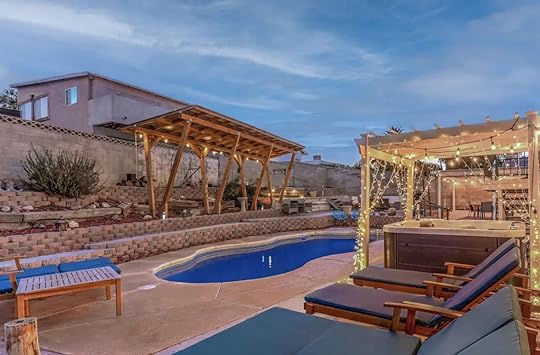 Photo: Airbnb
Photo: Airbnb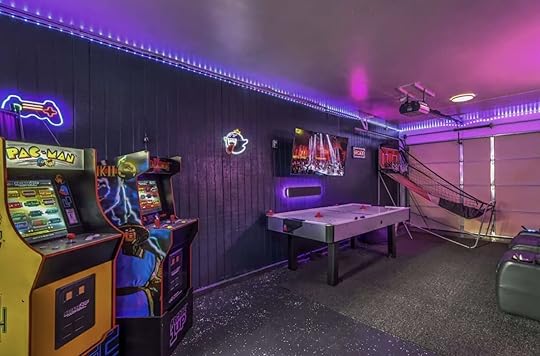 Photo: Airbnb
Photo: Airbnb Photo: Airbnb
Photo: Airbnb
If you want what most people would consider a party house — but don’t want to pay in the four-digits per night — this roomy home 10 minutes from downtown could be the perfect pick. It has four bedrooms, a billiards room with a flat-screen TV, and a converted garage with Pac-Man, air hockey, a Hot Shot basketball game, and more.
Of course, the reason you’d book this is because it’s an Airbnb in Las Vegas with a pool — but there’s more outside than just a pool. The outdoor space is almost as large as the indoor space, with a cabana, a Jacuzzi, lots of sun loungers, a firepit with lots of seating, and an outdoor grill and dining area. Divide the price by 10 guests, and you’ve got a really fun, really budget-friendly place to stay in Las Vegas.
Ten guests, four bedrooms
Price: $370 per night
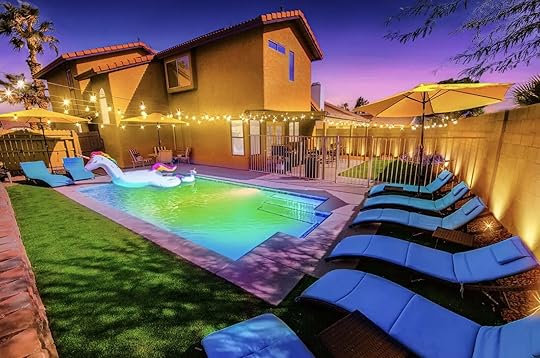 Photo: Airbnb
Photo: Airbnb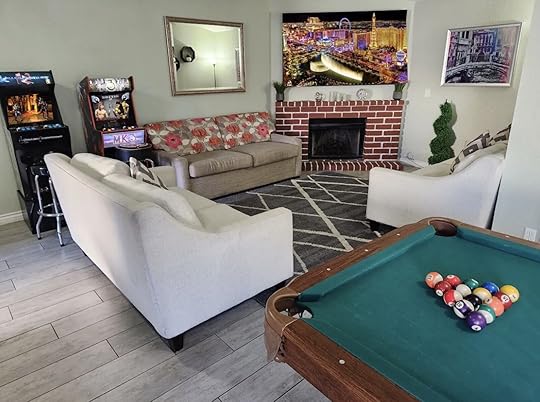 Photo: Airbnb
Photo: Airbnb Photo: Airbnb
Photo: Airbnb Photo: Airbnb
Photo: AirbnbThis is the largest Airbnb in Las Vegas with a pool you’ll find on this list. In fact, the property is so big that there’s not really even a limit, but the owners say it can fit at least 16. Those guests are spread between five bedrooms, three of which have bunk beds, so you really can pack people in. And really, given how much there is to do in this house, you may not spend much time sleeping, anyway.
Outside, there’s a private pool with half a dozen sun loungers, plus a three-hole putting green. There’s also a fire pit with lots of seating, an outdoor foosball table, and a grill and covered dining area. Inside, there’s a billiards table, several arcade games (Vegas owners seem to love their arcade games!) and an air hockey table. The bedrooms are kind of small, but it’s affordable enough that even a group of six or eight will find it to be a good deal.
Sixteen+ guests, five bedrooms
Price: $360 per night
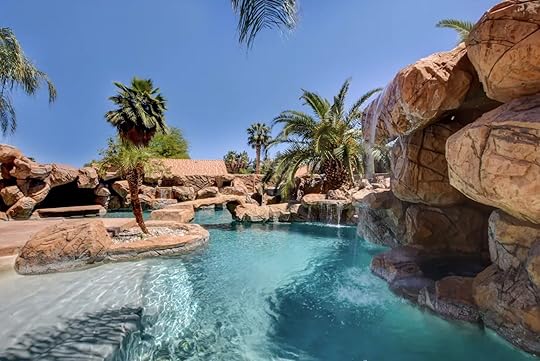 Photo: Airbnb
Photo: Airbnb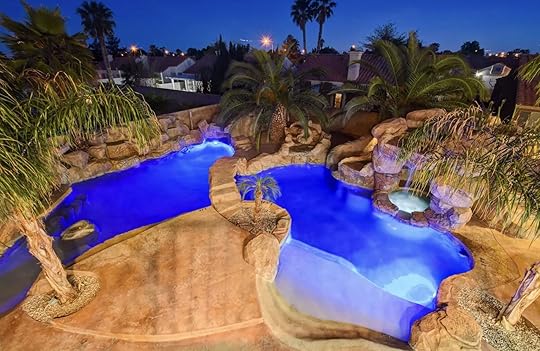 Photo: Airbnb
Photo: Airbnb Photo: Airbnb
Photo: Airbnb Photo: Airbnb
Photo: AirbnbIf you always thought it’d be fun to party at the Playboy Mansion but don’t actually want to share the pool, this house is an excellent fit. It has one of the prettiest pools of any Airbnb with a pool in Las Vegas, with a giant grotto-style pool divided by an over-pool walkway, plus an attached hot tub with waterfalls cascading over house-sized piles of rocks. It truly looks like a miniature version of something you’d find at one of the fancy Las Vegas hotels on the Strip.
The roomy home also has a full-sized pool table, four roomy bedrooms, and plenty of indoor and outdoor seating for everyone. It’s also dog friendly, making this an excellent pick for travelers driving to Vegas and bringing their furry friends along. Like a few other Las Vegas Airbnbs with pools on this list, there’s a daily fee for heating the hot tub (which the owners will detail and can bill in advance).
Eight guests, four bedrooms
Price: $525 per night
 Photo: Airbnb
Photo: Airbnb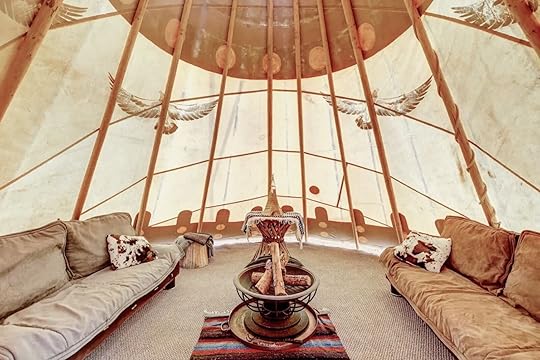 Photo: Airbnb
Photo: Airbnb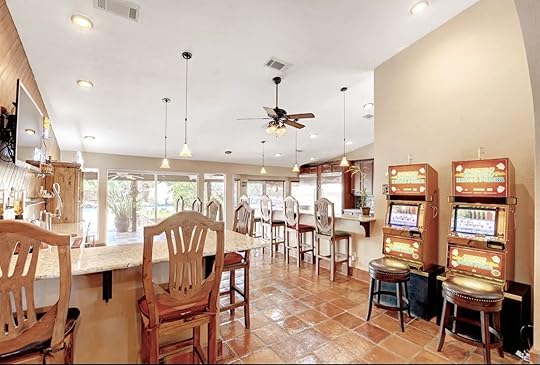 Photo: Airbnb
Photo: Airbnb Photo: Airbnb
Photo: AirbnbThis unique Airbnb with a pool in Las Vegas channels everything the western city is known for: southwestern vibes, subtle influences from south of the border, warm colors and cacti, and even a slot machine or two. The large outdoor area has a resort-style pool surrounded by palms and cacti, plus a full outdoor kitchen complete with a small bar. But the coolest feature may be the roomy teepee with plenty of seating, plus a central fire pit (there’s a backyard fire pit, too).
Inside, renters get an expansive living space with a downright massive kitchen and separate bar area (with two slot machines, no less!) The house sleeps 10 guests in eight beds, so you don’t have to have everyone double up — heck, you could even have someone sleep in the teepee. Note that there’s a small extra fee for heating the hot tub.
Ten guests, four bedrooms
Price: $580 per night
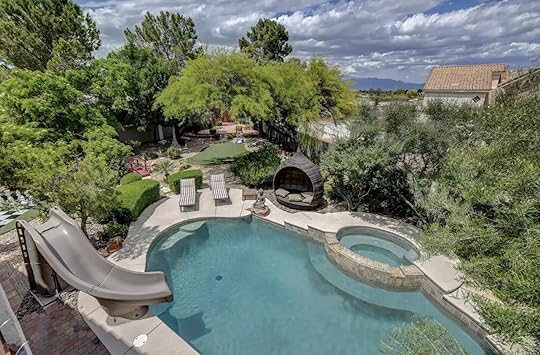 Photo: Airbnb
Photo: Airbnb Photo: Airbnb
Photo: Airbnb Photo: Airbnb
Photo: Airbnb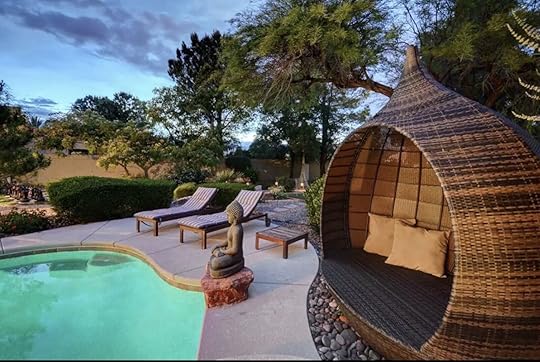 Photo: Airbnb
Photo: AirbnbThe Buddha Estate sits about a 15-minute drive from the Las Vegas strip and is basically your own private resort in the form of a rental home. Sure, it’s a Las Vegas Airbnb with a pool, but it’s also an Airbnb with an outdoor putting green, a peaceful hammock area, a putting green, a giant chess board, and a basketball court — and that’s just the outdoor features. Inside, renters get a home gym with a Peloton bike, a sauna, and a game room with foosball and billiards tables.
The home has seven beds across four bedrooms, plus tons of space for people to sleep on couches. And the outdoor space is ideal for relaxing, too, with loungers, Balinese-style woven chairs, and a roomy hot tub. It’s one of the biggest pools of any of the Airbnbs in Las Vegas and even has a small waterslide — bonus points if you can make a three-pointer while sliding into the pool.
Twelve guests, four bedrooms
Price: $664 per night
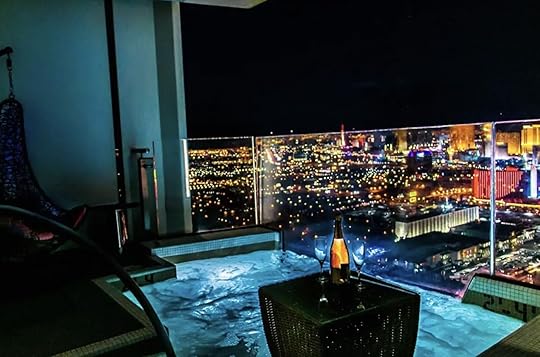 Photo: Airbnb
Photo: Airbnb Photo: Airbnb
Photo: Airbnb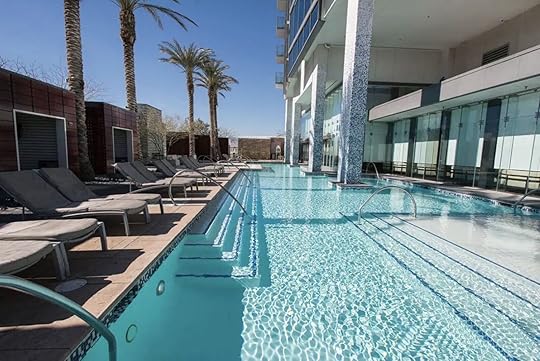 Photo: Airbnb
Photo: Airbnb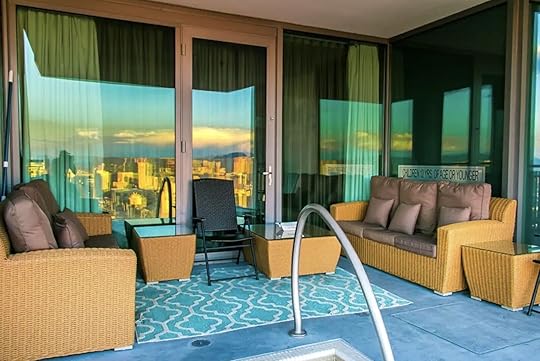 Photo: Airbnb
Photo: AirbnbThe Penthouse at the Palms is the quintessential Las Vegas condo. It’s at the Palms (naturally), and has a high-rise private Jacuzzi with absolutely amazing view of Sin City. Oh, and it has two more hot tubs inside. It’s the perfect place to stay if you’re trying to recreate The Hangover (though we’d advise not doing that).
In addition to getting full use of the swanky three-bedroom condo, renters also get to use the facilities at the Palm Resort. That includes the resort pool, complete with in-pool couches, plus the Laguna pool. Both have rentable cabanas and bar service.
This Airbnb doesn’t come cheap, but if you want a true Las Vegas-style experience, it’s the place to book.
Eight guests, three bedrooms
Price: $1,144 per night
$20 million estate with pool
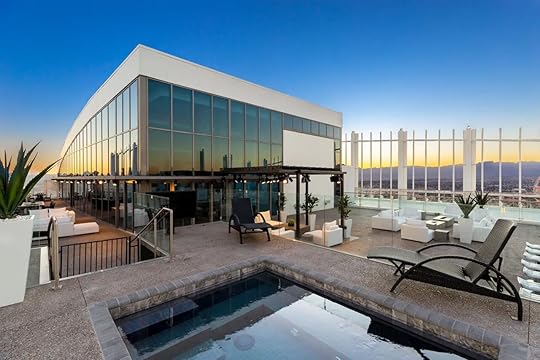 Photo: Airbnb
Photo: Airbnb Photo: Airbnb
Photo: Airbnb Photo: Airbnb
Photo: Airbnb Photo: Airbnb
Photo: AirbnbSee more photosIf your budget allows, check out this penthouse, which covers an entire floor, over 6,300 square feet indoors, and an additional 15,000 square feet of outdoor living space. This penthouse is designed for extravagant entertaining. It’s located on the top floor of the Palms Place building, giving you unobstructed 360-degree views through floor-to-ceiling windows of the Las Vegas Valley and the Strip. You can also enjoy the views from the communal rooftop pool and hot tub.
Sixteen+ guests, four bedrooms
Price: $2,991 per night
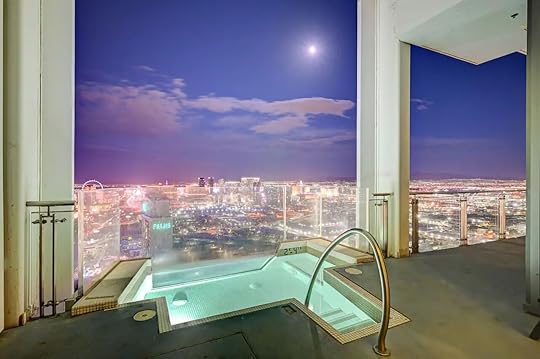 Photo: Airbnb
Photo: Airbnb Photo: Airbnb
Photo: Airbnb Photo: Airbnb
Photo: Airbnb Photo: Airbnb
Photo: AirbnbSee more photosThis is another penthouse option in the Palms Place building. Although it’s not directly part of the Palms Casino Resort, it’s connected via a walkway, granting easy access to its amenities, including restaurants, bars, the pool, and entertainment options. There are two master bedrooms, each with en-suite bathrooms, and a third room with a queen. The spacious outdoor balcony features a Jacuzzi hot tub with views over the city.
10 guests, three bedrooms
Price: $658 per night
 Photo: Airbnb
Photo: Airbnb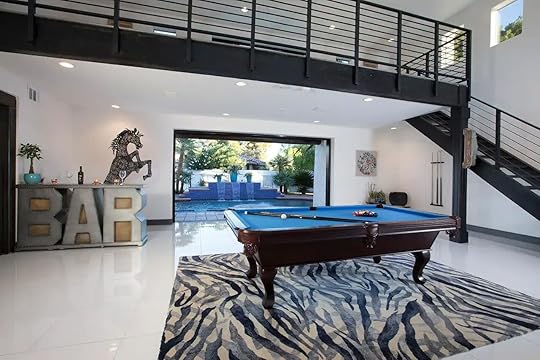 Photo: Airbnb
Photo: Airbnb Photo: Airbnb
Photo: Airbnb Photo: Airbnb
Photo: AirbnbSee more photos
If you’re going to Vegas for the glitz and want a home base with outdoor space, check out this mega-modern luxury four-bedroom house. It’s 1.5 miles from the Strip but has a huge private backyard, perfect after a night cap after a night out in town. The spacious, single-story home has ample space to spread out, so it’s ideal for families or groups traveling together. In the yard, the pool has waterfalls and is heated year-round, and there are pool toys for the young at heart.
Eight guests, four bedrooms
Price: $1,126 per night
 Photo: Airbnb
Photo: Airbnb Photo: Airbnb
Photo: Airbnb Photo: Airbnb
Photo: Airbnb Photo: Airbnb
Photo: AirbnbSee more photosThis Vegas Airbnb is operated by a professional host, Superhost Elevated Rentals. Being one of the more expensive on this list, you get a few more extras. First is space and five generous and themed master suites. It also has a bunch of amenities. There’s a game room with a pool table, ping pong, and a “four-in-one” TV where you can watch multiple entertainment options simultaneously – perfect for live sports enthusiasts. The living area also has arcade games. Outside, you’ll find a fully refinished pickleball and basketball court and a large swimming pool with loungers. The patio area (with kids’ play set) is surrounded by foliage, trees, flowers, fruits, and grass – no desert scrub here.
Thirteen guests, five bedrooms
Price: $945 per night
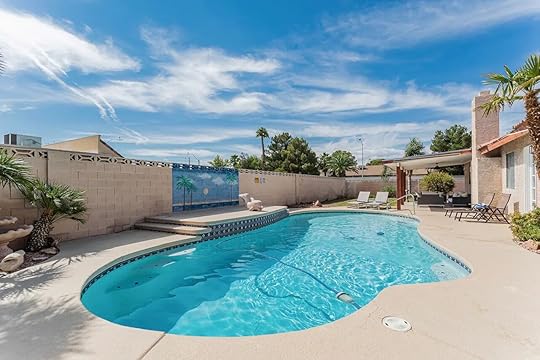 Photo: Airbnb
Photo: Airbnb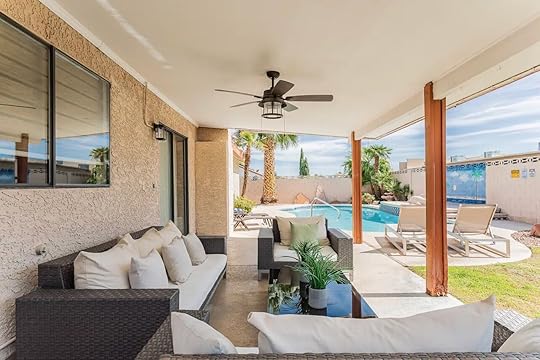 Photo: Airbnb
Photo: Airbnb Photo: Airbnb
Photo: Airbnb Photo: Airbnb
Photo: AirbnbSee more photos
This one-story residential home has a large backyard, patio furniture, and a private swimming pool. The modern home has everything you need, including a shuffleboard table for indoor fun. It’s situated in Spring Valley, and despite this neighborhood’s suburban feel, it’s conveniently located just west of the Strip, which is around 15 minutes by ride share. If you’re looking for a more local and authentic experience of Vegas, this is one to bookmark.
Eight guests, three bedrooms
Price: $328 per night
 Photo: Airbnb
Photo: Airbnb Photo: Airbnb
Photo: Airbnb Photo: Airbnb
Photo: Airbnb Photo: Airbnb
Photo: AirbnbSee more photosThis five-bedroom is in an area that used to be known as the Beverly Hills of Vegas, so there are some big old houses here. This rental has excellent reviews, with past guests raving about the considerable backyard space, pristine outdoor pool, floor-to-ceiling windows allowing natural light, and indoor pool table. There are two master suites, and three other bedrooms with a capacity to sleep up to 10 adults.
Ten guests, five bedrooms
Price: $680 per night
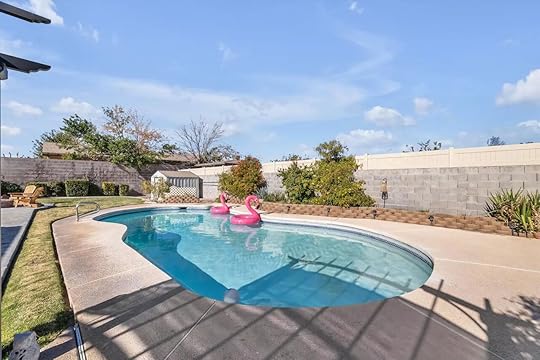 Photo: Airbnb
Photo: Airbnb Photo: Airbnb
Photo: Airbnb Photo: Airbnb
Photo: Airbnb Photo: Airbnb
Photo: AirbnbSee more photosThis peaceful and stylish three-bedroom villa is about 15 minutes from the Strip, making it another excellent vacation rental for those who want to dip in and dip right back out. It sleeps eight with the additional pull-out couch-turned-bed. The yard has super amenities, including grilling facilities, a fire pit, and a pool with fun inflatables.
Eight guests, three bedrooms
Price: $364 per night
 Photo: Airbnb
Photo: Airbnb Photo: Airbnb
Photo: Airbnb Photo: Airbnb
Photo: Airbnb Photo: Airbnb
Photo: AirbnbSee more photosThis luxury four-bedroom Airbnb offers both tranquility and easy access to the excitement of Vegas. It’s near the 12th fairway of the Las Vegas National Golf Course, a quieter suburban area. That does not mean it’s not attracted some famous faces, though. The neighborhood has had some notable residents throughout its 50-year history, including Dean Martin, Debbie Reynolds, Howard Hughes, and Bobby Darin. The nearby golf course country club was also a popular hangout spot for the Rat Pack. The home has an open floor plan, allowing for natural light and lots of space for entertaining. The swimming pool and spa are heated year-round, and depending on availability, you can also request a yurt set-up for the backyard, complete with outdoor seating – the perfect place to retreat away from the desert sun.
Eight guests, four bedrooms
Price: $557per night
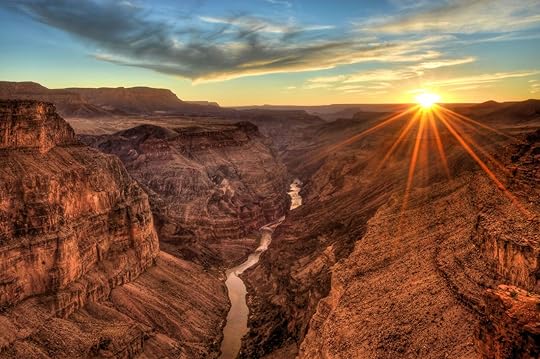
Photo: SierraLara/Shutterstock
The distance from Las Vegas to the Grand Canyon is approximately 275 miles, which is about a 4.5-hour drive. You can go either to the South or North Rim. The South Rim is more popular and more developed in terms of amenities and activities. There are several lodges and campgrounds in the area, as well as a visitor center, restaurants, and gift shops. You can drive to many scenic viewpoints along the rim, but taking the park shuttle will alleviate the hassle of dealing with traffic or finding parking.
The North Rim is more remote and harder to reach, but many people consider it to be more peaceful and less crowded than the South Rim. There is only one lodge and one campground in the area, so you’ll want to book your accommodations well in advance if you’re pairing Las Vegas and the Grand Canyon in one trip. Note that the North Rim is closed between November and May, so don’t plan to head there unless you’re willing to snowshoe your way in (which you actually can do).
How far is Las Vegas from the Hoover Dam?
Photo: Nido Huebl/Shutterstock
Las Vegas is approximately 30 miles northwest of the Hoover Dam. Without traffic, it takes about 45 minutes. You can drive yourself, or book a tour from Las Vegas to the Grand Canyon. Good options include the half-day Hoover Dam Express Tour, with a guided dam tour and time to explore on your own; a three-hour Pink Jeep Tour that includes narration on the history of the area’s geology and people; or even tours where you can paddle on Lake Mead in front of the Hoover Dam.
If you prefer not to take a tour, you can definitely drive to the Hoover Dam on your own. It’s an easy drive from Las Vegas and there’s usually plenty of parking. You can pay for a self-guided tour in advance online or sign up for a guided tour when you arrive ($30 per person).
Where to stay in Las VegasThough the famous Las Vegas strip is the most well-known part of the city, it’s hardly the only place to stay in Las Vegas. The strip is where you’ll find most of the famous hotels like The Venetian or The Bellagio, so most of the Airbnbs in that area are likely to be condos within hotels.Another area to stay is downtown Las Vegas, which is more local and is more like a “normal” city. It’s home to the Fremont Street Experience (a canopy of LED lights and three stages with live entertainment most evenings). If you want to visit Lake Mead and the Hoover Dam while in Vegas, you may want to stay in Henderson, about 20 minutes southeast of the Vegas strip.
Las Vegas is very drivable and in the middle of a dessert, so it doesn’t take too long to get out of the city. But if you want to visit famous outdoor areas like Valley of Fire State Park and the Desert National Wildlife Refuge, stay on the northern part of Las Vegas. If you’re headed to Red Rock Canyon or planning a day trip to Death Valley National Park, stay on the west side of Las Vegas to make your drive a smidge shorter. 
May 23, 2024
Google Flights Can Now Finally Show Prices for Southwest Airlines

In a change that’s likely to make budget-conscious travelers very happy, Google Flights recently added Southwest Airlines to its flight comparison tool.
Now, travelers can see Southwest Airlines side-by-side with rates for other airlines. Southwest Airlines was not included in Google Flights prior to late May of this year, and travelers would have to run a separate search via Southwest.com to find flight costs. It’s not clear exactly why the airline was excluded from search results, though it’s long been speculated that it was a decision by Southwest to retain as much profit as possible, rather than paying a small share of each booking to Google.
However, there’s a catch: It may not be a permanent change. Southwest Airlines told multiple news sources that it’s only a pilot program, and flights can still only be booked through Southwest.com, rather than via any other airfare retailer. As for why the airline finally partnered with Google after 12 years (Google Flights launched in 2011), it’s anyone’s guess. But multiple theories have been proposed, including the idea that Southwest’s lack of checked bag and seat selection fees may make its rates look more favorable in comparison to other airlines, especially since the Department of Transportation recently mandated that airlines must disclose all additional fees upfront.
Southwest has also toyed with additional business changes in public recently, saying it’s considering moves like offering assigned seating or creating different tiers of service.
Current Southwest deals for summer 2024Southwest is regularly one of the lowest-priced airlines among the major US-based carriers, but as of May 2024, it has some extra-juicy deals for upcoming summer travel. Remember that the cheapest rates are usually only offered on specific days, so if you can fly midweek, you’re more likely to find a great deal. Southwest has this useful flight-searching tool where you can see the lowest-priced fair to various destinations, based on your home airport. You may need to run a few different searches on different days to find the best deal, as Southwest frequently runs sales that last only a few days.
San Diego, California
Photo: Jon Bilous/Shutterstock
If you’re hoping to plan a trip to the beaches of San Diego, you’re in luck. Flights from San Francisco or Los Angeles to San Diego start at $70 each way. From Seattle, WA, it’s $129 each way to San Diego, and just $118 each way from Denver, CO. Even East Coasters can get to San Diego fairly cheaply, with reasonably priced one-way flights from Atlanta, GA, and Washington, DC ($149), and Hartford, CT (at $199). In San Diego, visitors can see wild seals and sea lions, stay in a Hobbit-themed Airbnb, sightsee at national monuments and art galleries, or just chill out at airy Airbnbs on the beach for a few days.
Cancún, Mexico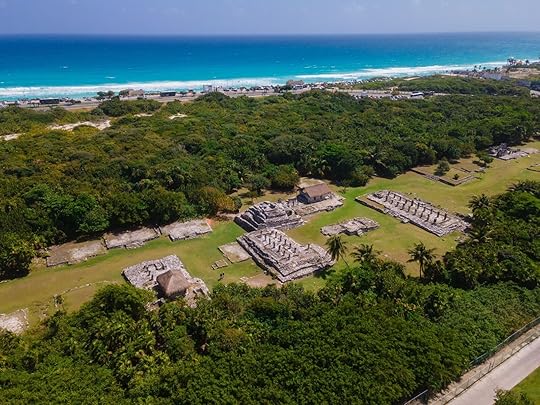
The el Rey archeological site near Cancún MX. Photo: Mardoz/Shutterstock
If you like your beach vacations with a side of archaeology, excellent food, and even scuba diving with sharks, you may want to book a cheap flight to Cancún this summer. From Chicago, IL, or Houston, TX, one-way flights are as low as $111, and only a few bucks more from cities like Phoenix, AZ ($180) or New Orleans, LA ($169). In Cancún, travelers can snorkel or scuba dive through an underwater art museum, try some of the best mezcal in the country, or splurge for a luxury beachfront hotel with private cabanas and all manner of inclusive beach adventures.
Honolulu, Hawai’i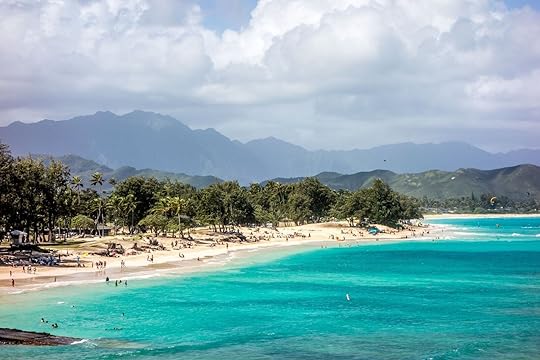
Photo: KarlosXII/Shutterstock
While it’s a bit of a haul for East Coast-based travelers, anyone who lives toward the western part of the US can probably find a screaming deal on flights to Honolulu, on the island of Oahu. This summer, one-way flights to Honolulu are as low as $183 from Oakland, CA; $215 from Phoenix, AZ, and Las Vegas, NV; or $161 from Los Angeles, CA. In Honolulu, visitors can check out family-friendly tropical hikes, learn to surf on world-famous waves, or rent a beachfront Airbnb in Waikīkī and work with views of the Pacific Ocean for a few days of living the high life. 
Understanding Japan’s Cuteness Culture With the Founder of the ‘Cute Studies’ Academic Field in Tokyo

When I took my then-one-year-old daughter to Japan last year, I was already very accustomed to people stopping and telling me I have a cute baby. That didn’t prepare me for just how often we would hear that statement in Tokyo and Kyoto — so often, in fact, that the Japanese word for cute, kawaii (pronounced similar to the Hawaiian island), was quickly one of the first Japanese words I learned. Single guys, women, even groups of kids from elementary age to high school seemingly never held back when it came to a passing compliment of “totemo kawaii!”
Cuteness is ingrained throughout Japanese life, from animal cafes and cartoons to Hello Kitty on construction signs. On the latest episode of the Matador Network podcast No Fixed Address: The World’s Most Extraordinary People, host Michael Motamedi travels to Tokyo to speak with Joshua Paul Dale, Ph.D., a professor at Tokyo’s Chuo University, founder of the academic field of cute studies, and author of the forthcoming book How Cuteness Wired our Brains and Changed the World (Profile Books, November 9, 2024).
Cuteness, Dale explains on the podcast, is universal. Studies have shown that seeing something cute — whether that’s a puppy, a baby, a drawing, or anything else — releases oxytocin, prepares people for empathetic and highly social interactions, and increases fine motor control. What is deemed cute differs slightly from place to place and person to person. That said, there are a few commonalities across cultures like big eyes, round foreheads, and chubby cheeks (collectively called the “baby schema”).
Dale and Motamedi meet in Tokyo’s Harajuku neighborhood, what they call the “epicenter” of Japan’s kawaii culture. Dale first came to Tokyo in the early ‘90s. At that time, Harajuku was filled with bands and dancers every Sunday. Dale was more interested in the avant garde side of Japanese art and performance — particularly butoh dancers where performers shave their heads and paint themselves white.
“And then about 10 years ago, I just began to notice that there’s all this cute stuff around,” Dale says on the podcast. Kawaii was increasingly in the public sphere, from “cutified” police officer statures to rainbow-toting Hello Kitty signs taking the place of road construction barriers.
“It was just a new way of intervening in public space by giving people something that they enjoyed while telling them that they couldn’t go somewhere or they couldn’t do something,” Dale explains. He adds that “the way that cute culture has developed in Japan as compared to the United States is distinctly different.”
To hear the full conversation and hear how cuteness culture has shaped our lives, consumerism, and even the animals we call pets, listen to the episode on Spotify, Apple Podcasts, or your favorite listening app. 
This No-Kill Shelter Now Has a Hotel Where You Can Spend the Night With Your Future Pet
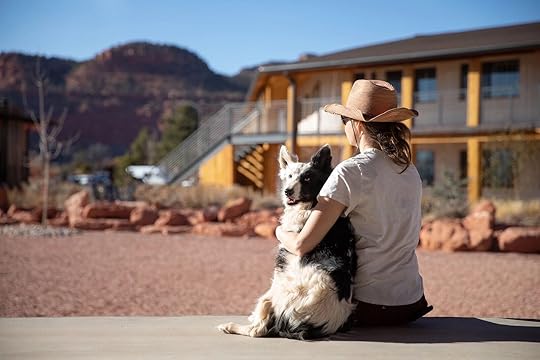
Few greater gifts exist than adoption, and adopting a pet is a mutually beneficial arrangement in terms of boosting the sheer joy taken from each day. Now, adding a new pet to your household is also the perfect justification to take a road trip to Utah’s canyon country. Best Friends Animal Sanctuary is a no-kill temporary home for dogs, horses, cats, and other animals located just outside the small town of Kanab. The organization recently opened a hotel in town, Best Friends Roadhouse and Mercantile, where guests can spend the night with their potential new family member before bringing them home.
We hope you love Best Friends Roadhouse and Mercantile! Just so you know, Matador may collect a small commission from the links on this page if you decide to book a stay. Listed prices are accurate as of the time of publication.
Building Best Friends Animal Sanctuary, the largest no-kill shelter in the US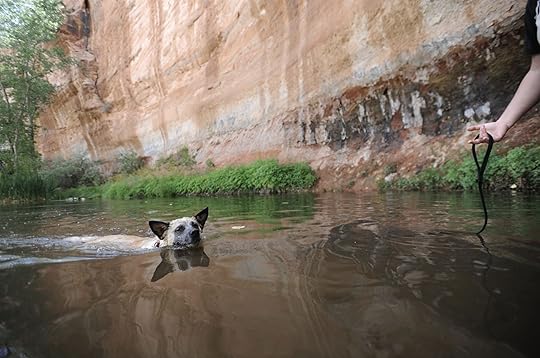 Photo courtesy Best Friends Roadhouse and Mercantile
Photo courtesy Best Friends Roadhouse and Mercantile Photo courtesy Best Friends Roadhouse and Mercantile
Photo courtesy Best Friends Roadhouse and Mercantile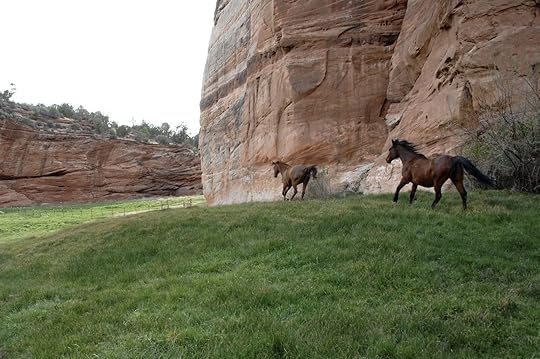 Photo courtesy Best Friends Roadhouse and Mercantile
Photo courtesy Best Friends Roadhouse and Mercantile Photo courtesy Best Friends Roadhouse and Mercantile
Photo courtesy Best Friends Roadhouse and MercantileThe sprawling 20,000-acre sanctuary facility started in 1984 with a single building. It now houses 175 buildings to provide a haven for up to 1,600 animals at any given time, including dogs, cats, horses, birds, rabbits, pigs and many others. Some of the animals are rescued from traumatic circumstances and come to Best Friends to receive the care and healing they need before finding their forever homes. Visitors can explore the sanctuary through guided tours or volunteer to spend quality time with the animals themselves.
“We want to promote a better world through kindness to animals and bring about a time where there’s no more homeless pets,” says Julie Barger, Director of Experience at Best Friends Animal Sanctuary.
Many of the dogs arrive from a local pound after finishing a 10-day stray hold. Best Friends also seeks animals in danger of being euthanized at facilities across the country. Many of these animals are sick or have experienced trauma and need care urgently, but end up in facilities unable to meet their needs.Best Friends Roadhouse and Mercantile – the world’s greatest pet-friendly hotel? Photo courtesy Best Friends Roadhouse and Mercantile
Photo courtesy Best Friends Roadhouse and Mercantile Photo courtesy Best Friends Roadhouse and Mercantile
Photo courtesy Best Friends Roadhouse and Mercantile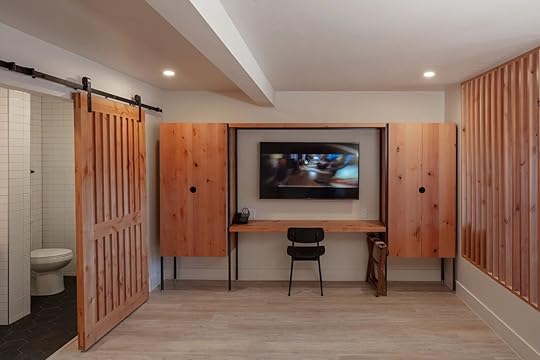 Photo courtesy Best Friends Roadhouse and Mercantile
Photo courtesy Best Friends Roadhouse and Mercantile Photo courtesy Best Friends Roadhouse and Mercantile
Photo courtesy Best Friends Roadhouse and MercantileBest Friends Roadhouse and Mercantile is a hotel. That said, it’s not your typical motor lodge. Rather, it may be the most pet-friendly lodging property ever to exist – guests, even those not planning to adopt, can bring up to four pets with them for no extra charge. It’s affiliated with Best Friends Animal Sanctuary. The 40 rooms and suites are modern and feature amenities designed specifically for pets. Each room has easy access entrances and cozy nooks for animals to relax. They also feature a dog washing station and a fenced-in dog park with a splash pad. The rooms come in standard sizes with either a king bed or one or two queen beds. Each room offers a separate sleeping and sitting area, a private bathroom with an open vanity, and a desk and wardrobe. There’s a slide-out for extra sleeping space – they do allow up to four pets per room, after all – and solid views of the canyon country outside Kanab. Rates start around $203 per night.
“The main reason we have the hotel is because it’s tied to the sanctuary,” Barger says. “We want to have a really pet-friendly place for all of our visitors that are coming to the sanctuary to volunteer to stay worry-free with their pets.”
The pet-first vibe makes the hotel a great place to spend the night with pets from the sanctuary – even those not (necessarily) planning to adopt. Each room is equipped with pet beds built into the wall, cubbies for smaller animals like cats, and other animal amenities. The property has a gift shop — the mercantile — that sells clothes and goods supporting the sanctuary (you know you want a t-shirt with a cue pig on it to commemorate your stay).
It’s also an excellent place to base an outdoor adventure trip to southern Utah.
“You can combine the Roadhouse and the sanctuary with hiking in the national parks and exploring the canyons for a full-week vacation,” Barger says. “We also have sand caves with free parking right outside the sanctuary, and hiking trails in the sanctuary including a hidden lake that’s about 20 degrees cooler than outside.”

Photo courtesy Best Friends Roadhouse and Mercantile
The only condition to bringing pets is that if you are planning to have a sleepover with an animal from the shelter, your other pets must stay home.
“It’s open to the public, you don’t even have to have a pet to stay,” Barger says. “A lot of people stumble upon it because it’s beautiful and centrally located. People say, ‘We miss our pet at home, let’s give a shelter pet the chance to sleep out of their kennel.”
This allows the sanctuary staff to learn more about the pets than most other shelters are able to glean, including how they behave around other animals. Then, staff are better able to find their appropriate permanent homes.
If you visit the Best Friends Sanctuary or Roadhouse and Mercantile, stop by the vegan buffet
Photo courtesy Best Friends Roadhouse and Mercantile
For $5, guests and visitors can eat lunch at Best Friends’ vegan buffet from 11:30 AM to 1 PM 365 days per year. At the sanctuary, the staff feed up to 250 people per day, many of whom are staff and volunteers. The cafe looks over Grand Staircase-Escalante National Monument. The kitchen is run by a certified vegan chef.
Those staying at the Roadhouse can take advantage of the hotel’s vegan continental breakfast, which features baked goods, proteins, and cereals served with plant milks, along with specialty coffee drinks. 
Book Best Friends Roadhouse and Mercantile
More like thisSustainability7 of the Coolest Wildlife Crossings Around the WorldNorwegian Introduces Dozens of New Asia Cruises for 2024 and Beyond
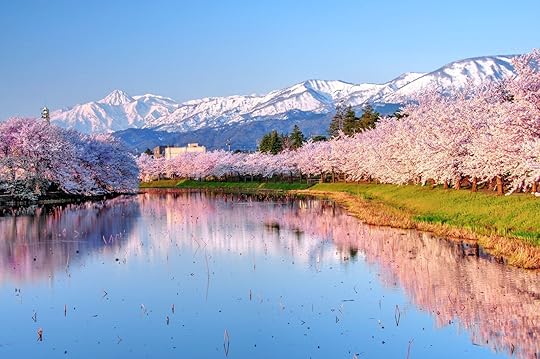
It’s no secret that cruising as a vacation activity is more popular than ever, and Norwegian Cruise Line’s CEO Harry Sommer recently shared publicly that millennials and Gen-Z travelers are the fastest-growing segment for the large cruise line.
So it should come as no surprise that NCL is introducing new cruises in a region adored by younger travelers since international travel became available to the average person: Asia. Norwegian Cruise Line introduced recently a whopping 30 new cruises throughout Asia — meaning that the traditional “backpack through Asia” trip taken by so many 20-somethings after college could now be a “cruise through Asia” trip. (Though, granted, it’s harder to party all night at an international bar when you have to be back on the ship by 9 PM.)

Norwegian recently shared that Gen-Z and Millennials are the fastest-growing segment of the cruise market. Photo: alphaspirit.it/Shutterstock
The new itineraries sail through the Asia Pacific region, as well as Australia and New Zealand. That brings the total number of trips available between September 2024 and August 2025 to 40. Cruises and costs range from a 17-day cruise to celebrity-loved islands like Maldives and Seychelles, with rooms priced between $3,699 and $15,399 per person, to a more affordable 11-day cruise making stops in Thailand and Vietnam, where inside room start at $949 per person. Cruises range from 9 to 19 days, leaving from 15 ports ranging from Vancouver to Manilla.
In the release, NCL President David J Herrera said that the huge investment into Asian destinations is to create offerings to more off-the-beaten-path destinations that may be harder to reach with other cruise companies. “With the increased interest in more immersive and exotic itineraries,” quotes the release on behalf of Herrera, “we are excited to expand our season and offer additional ships to cater to travelers looking to uncover the most sought-out cities in the region, but also those less discovered.”
Countries in Asia are predicted to be among the fastest-growing tourism destinations in 2024 and 2025. And while it’s tough to group a region of nearly 50 distinct countries and cultures into one generic trend, researchers predict that the region overall will see a 20 percent jump in tourism in 2024 over 2023. That number is far less for other global regions like Europe, predicted to grow by only about five percent.
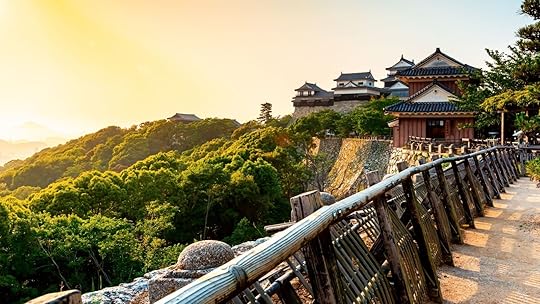
Matsuyama Castle in Matsuyama, Japan, one of several new ports on the new Norwegian Asia cruises. Photo: TierneyMJ/Shutterstock
The roughly 30 new cruises will collectively stop in more than 60 cities and ports, including nine brand new to the brand. In Australia, cruisers can stop in Albany, Townsville, Port Douglas, Freemantle, and Busselton; and in Japan, port stops include Matsuyama and Niigata. Also new are Aitutaki in the Cook Islands, and Suva, on Fiji’s main island of Viti Levu. Also new are overnight stops on the islands of Bali and Lombok in Indonesia, allowing passengers to stay out late or spend the night on the islands.
The cruises are spread across Norwegian’s Sun, Sky, and Spirit ships. The three ships hold nearly 2,000 guests each but are still among the smallest in Norwegian’s fleet, making them ideal for travelers looking for a more intimate experience without the flashy entertainment draws of larger ships, like go-karts and waterslides. The smaller sizes also allow the new Norwegian Asia cruises to reach smaller ports inaccessible to larger ships (and make it much faster for guests to get on and off the ship quickly at port). 
New Tallest Waterslide in North America: Wisconsin Waterpark Debuts 145-Foot-Tall Slide This Memorial Day Weekend

In 2019, Royal Caribbean announced what it claimed was North America’s tallest waterslide: Daredevil’s Peak, a 135-foot-tall slide on a private island in The Bahamas. Mt. Olympus Water and Theme Park in Wisconsin Dells, Wisconsin, takes things up another 10 feet with the new slide, The Fall, opening over Memorial Day weekend this year.
The 145-foot-tall slide takes the award for the new tallest in North America. It’s part of a five-slide tower called The Rise of Icarus, which has four other slides that take off from the middle platform at 60 feet high. It’s joined by a new milder children’s section called Icaria Splash ‘n Slide that’ll open on July 4 with 10 slides and a 12,000-square-foot kid-to-pre-teen area.
The Icarus of legend met an unfortunate end when he flew too close to the sun. Though borrowing the name, there will not be any catching fire on this waterslide.
Wisconsin Dells is just north of Madison and only has a population of about 3,000 people, but its reputation among theme park fans is much larger. Here, you’ll find a ride range of man-made parks ranging from water parks (more than 20 of them, to be exact), to a race track, to a ropes course. It’s also a draw for nature — and parks built into nature like the Land of Natura inflatable waterpark that’s the largest of its kind in America and on the world’s largest naturally filtered man-made lake.
When it comes to waterslide thrills, though, nothing can top The Fall, as photos show.

Photo: Mt. Olympus Water and Theme Park
The park is one of the largest in Wisconsin Dells. The Greek-themed resort has 1,600 rooms, indoor and outdoor waterparks (like the country’s first rotating waterslide), roller coasters (including the world’s first underground roller coaster), go-kart tracks, and replicas of the Trojan Horse and Roman Colosseum.
To get to Wisconsin Dells and Mt. Olympus Water and Theme Park, fly into Dane Co. Regional Airport in Madison (55 miles away), General Mitchell International in Milwaukee (116 miles away), or Chicago’s O’Hare International (188 miles away). 
15 Downtown St. Augustine Airbnb Rentals Near the Beach and Historical Sites
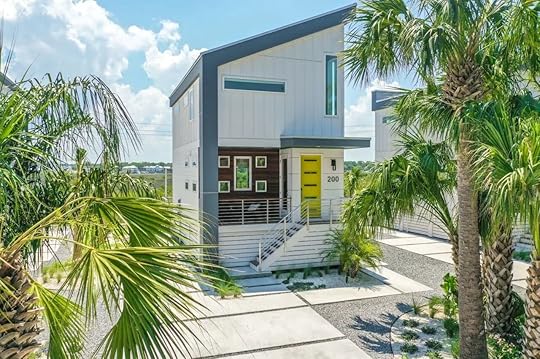
Welcome to the nation’s oldest city — St. Augustine, Florida. Commonly known as The Ancient City, St. Augustine is filled with many treasures and a unique history. The beach town reel visitors with deep green marshes, miles of beaches, and a town center filled with historical sites. These Airbnbs in the heart of St. Augustine give you easy access to the best of the city.
Traveling to Florida? Check out Matador’s Florida accommodations guides:15 beautiful Florida Airbnbs for every type of travelerThe best 11 Airbnbs near Universal StudiosThe 12 best Miami Airbnbs from South Beach to Little Havana8 of the coolest Airbnbs near Disney World, Florida15 beautiful Florida Airbnbs for every type of traveler6 Kissimmee Airbnbs for a multi-generational family Disney trip11 Key West Airbnbs to experience the best of the island11 gorgeous Florida Keys Airbnbs to catch the ‘Keys Disease’These New Smyrna Beach Airbnbs showcase the best of Florida’s central coast
We hope you love these St. Augustine Airbnbs! Just so you know, Matador may collect a small commission from the links on this page if you decide to book a stay. Listed prices are accurate as of the time of publication.
Downtown St. Augustine AirbnbsUnique Airbnbs in St. AugustinePet-friendly Airbnbs in St. AugustineDowntown St. Augustine AirbnbsBuba’s Bungalow Airbnb in downtown St. Augustine Photo: Airbnb
Photo: Airbnb Photo: Airbnb
Photo: Airbnb Photo: Airbnb
Photo: Airbnb Photo: Airbnb
Photo: AirbnbSee more photosBuilt in 1900, this downtown St. Augustine Airbnb has a convenient location just steps away from the city center. Comfortably accommodate your group with three bedrooms (one king-size bed and two queen-size beds) and three bathrooms spread across the property. Unwind after a day of exploration in the private backyard or soak up the sunshine on the front porch rocking chairs.
Six guests, three bedrooms
Price: $249 per night
 Photo: Airbnb
Photo: Airbnb Photo: Airbnb
Photo: Airbnb Photo: Airbnb
Photo: Airbnb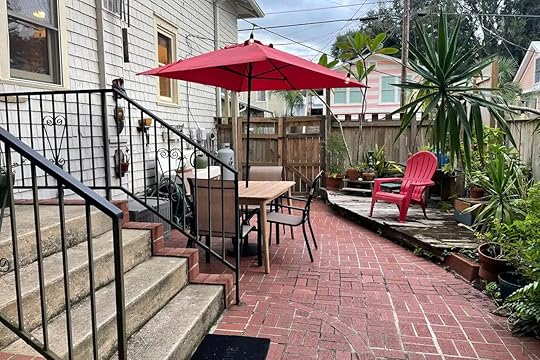 Photo: Airbnb
Photo: AirbnbSee more photosThe back of this apartment Airbnb near downtown features a private courtyard, perfect for enjoying a cup of coffee in the morning or a glass of wine in the evening. The layout is open-concept on the first floor, boasting plenty of natural light thanks to numerous windows. This level includes the living room, dining room, kitchen, and a downstairs bathroom. Upstairs, you’ll find two bedrooms and a bathroom, with the latter being connected to the master bedroom. The bedrooms are designed for relaxation and simplicity, providing a tranquil space to unwind during your stay.
Four guests, two bedrooms
Price: $134 per night
 Photo: Airbnb
Photo: Airbnb Photo: Airbnb
Photo: Airbnb Photo: Airbnb
Photo: Airbnb Photo: Airbnb
Photo: AirbnbSee more photosThis Airbnb in downtown St. Augustine offers two queen bedrooms, one on each floor, with private bathrooms. The entire house was recently renovated and features modern amenities like air conditioning, heating, Wi-Fi, and a smart TV. The backyard is fully fenced and includes a firepit, outdoor shower and tub, grill, and swing. Guests can also enjoy beach chairs, towels, books, games, and fully stocked bathrooms and kitchen.
The location is convenient for exploring the historic city of St Augustine. It’s a short walk to popular attractions like Fish Camp, Saint George Street, Flagler College, and the Lightner Museum. The beach and other destinations like the Alligator Farm and Outlet Mall are a short drive away.
Four guests, two bedrooms
Price: $248 per night
 Photo: Airbnb
Photo: Airbnb Photo: Airbnb
Photo: Airbnb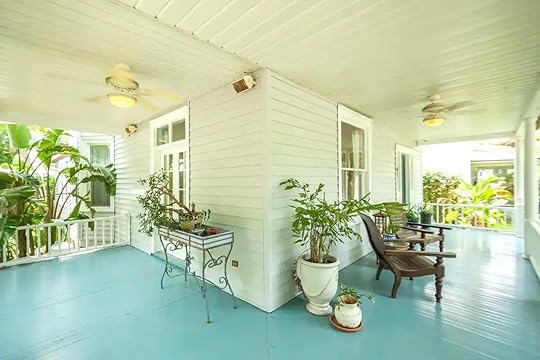 Photo: Airbnb
Photo: Airbnb Photo: Airbnb
Photo: AirbnbSee more photos
This Airbnb, a renovated 2500-square-foot home, is located in the historic district of St. Augustine in Casa Saragossa. The property boasts original architectural details, high ceilings, and hardwood pine floors throughout. The charm of southern living on the wrap-around porch or the private backyard deck is the key differentiator here, and what makes it a home worth visiting.
The layout features a large bedroom and bathroom upstairs, along with a second bedroom and bathroom. There is also a half bathroom located on the first floor. The location itself is ideal for exploring the historic district on foot, with easy access to restaurants, galleries, craft bars, historic landmarks, and the beach.
Four guests, two bedrooms
Price: $265 per night
 Photo: Airbnb
Photo: Airbnb Photo: Airbnb
Photo: Airbnb Photo: Airbnb
Photo: Airbnb Photo: Airbnb
Photo: AirbnbSee more photos
Relax at this Airbnb St. Augustine boho-themed getaway. This bohemian cottage is in the city’s heart and close to the historic St. George Street. The home features amenities such as a back porch, a spacious yard, and relaxing vibes for your trip to St. Augustine.
Two guests, one bedroom
Price: $97 per night
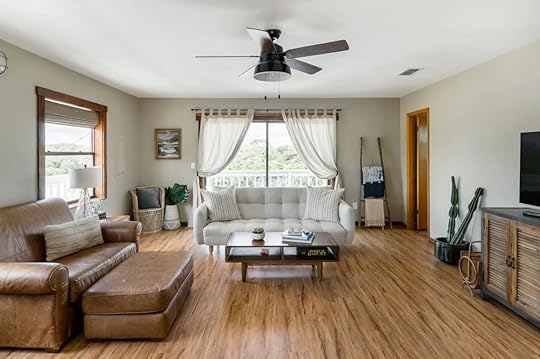 Photo: Airbnb
Photo: Airbnb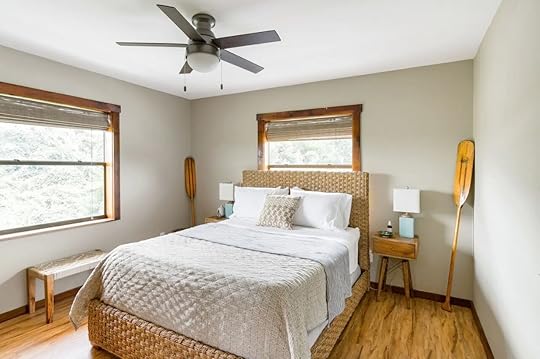 Photo: Airbnb
Photo: Airbnb Photo: Airbnb
Photo: Airbnb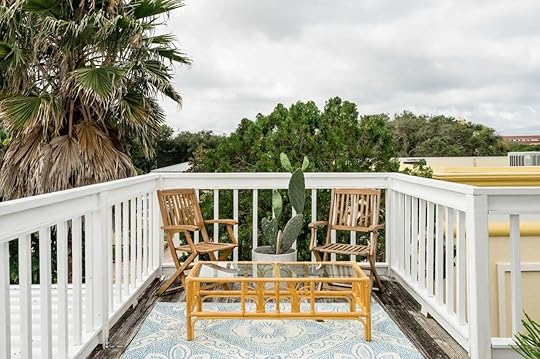 Photo: Airbnb
Photo: AirbnbSee more photos
Enjoy St. Augustine while staying at this comfortable contemporary home that is minutes away from the beach. This home features a spacious living area, a rustic-like kitchen area, and a wrap-around deck with gorgeous views and space to sit out, relax, and have a drink. The home is eight miles from the downtown area.
Three guests, one bedroom
Price: $155 per night
 Photo: Airbnb
Photo: Airbnb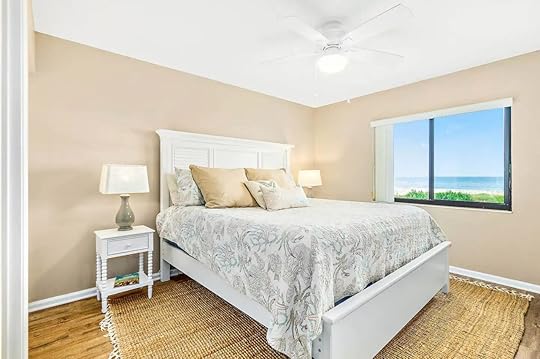 Photo: Airbnb
Photo: Airbnb Photo: Airbnb
Photo: AirbnbSee more photos
Step outside and smell the salty air and take in the breathtaking views of the beach at this St. Augustine condo. This rental features a spacious living and kitchen area and is only a short walk to miles and miles of beaches. It’s 10 minutes from the Old Town Historic District.
Five guests, two bedrooms
Price: $91 per night
 Photo: Airbnb
Photo: Airbnb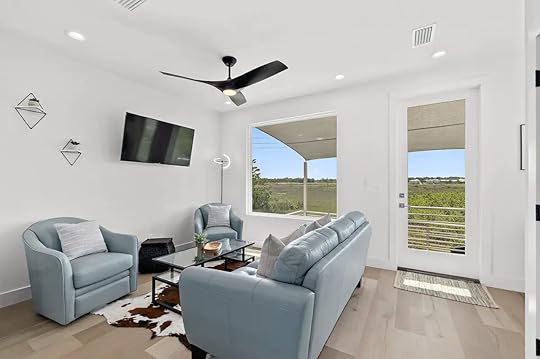 Photo: Airbnb
Photo: Airbnb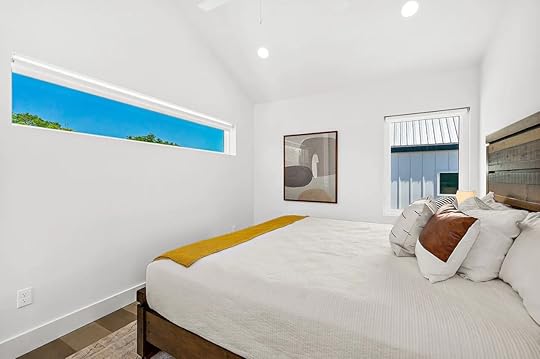 Photo: Airbnb
Photo: Airbnb Photo: Airbnb
Photo: Airbnb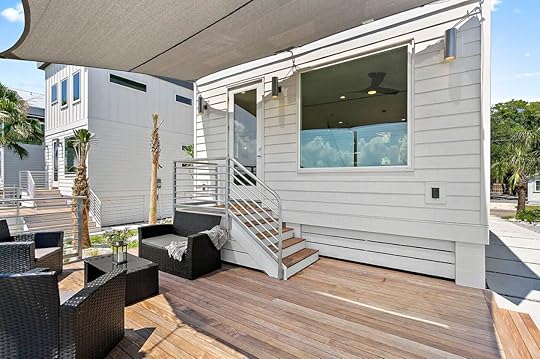 Photo: Airbnb
Photo: AirbnbSee more photos
Nestled along the tidal marshes of Oyster Creek is this modern townhouse. This townhouse features a gourmet kitchen, an open living area and stunning views of the marshes throughout the home, and a cozy patio area to sit out on and enjoy the weather.
Four guests, two bedrooms
Price: $165 per night
 Photo: Airbnb
Photo: Airbnb Photo: Airbnb
Photo: Airbnb Photo: Airbnb
Photo: Airbnb Photo: Airbnb
Photo: AirbnbSee more photos
This Airbnb is across the river from downtown, a spacious 1500-square-foot home with vaulted ceilings. It has two bedrooms, two and a half bathrooms, and can comfortably sleep six people. The home features modern furniture and plenty of natural light. The kitchen is fully equipped with stainless steel appliances and all the necessary cookware. There is an open-concept dining area with an island and a table for six. The living room has a chaise lounge sofa, a TV, and board games. There is also a dedicated workspace with a high-speed internet connection.
The master bedroom has a king-sized memory foam mattress and a full bathroom with a walk-in shower. The second bedroom also has a king-sized memory foam mattress and a full bathroom with a tub. Both bathrooms come with towels, toiletries, and a hairdryer. A washer and dryer are available for guest use. The backyard is well-manicured and has rocking chairs and furniture. Bicycles are also provided for free, but guests are responsible for their own safety while using them.
Six guests, two bedrooms
Price: $246 per night
 Photo: Airbnb
Photo: Airbnb Photo: Airbnb
Photo: Airbnb Photo: Airbnb
Photo: Airbnb Photo: Airbnb
Photo: AirbnbSee more photos
This 1400-square-foot Airbnb bungalow comes with great views from each of the two bedrooms and two bathrooms. It’s located on Anastasia Island and offers waterfront views. Guests can enjoy a king-sized bed in one bedroom and a queen-sized bed in the other. There is a deck overlooking the water, perfect for relaxing with a cup of coffee. The rental also features Wi-Fi and a smart TV in the living room.
The location is ideal for exploring historic St. Augustine. The property is directly across the water from downtown and within a two-mile radius of popular attractions like the Castillo de San Marcos fort, Anastasia State Park Beach, and the Alligator Farm. You’ll be able to easily walk to downtown via the Bridge of Lions or take an Uber or Lyft for a quicker commute due to limited parking options.
Four guests, three bedrooms
Price: $379 per night
 Photo: Airbnb
Photo: Airbnb Photo: Airbnb
Photo: Airbnb Photo: Airbnb
Photo: Airbnb Photo: Airbnb
Photo: AirbnbSee more photos
This Airbnb in St. Augustine is a lakeside retreat, the perfect place for your Florida getaway. This historic home is in the heart of Lincolnville, and the house is only eight minutes from downtown, with historical sights, restaurants, bars, and more. Enjoy the sights of the home with its fully fenced yard, heated pool, and spacious backyard with stunning views of Lake Maria Sanchez.
Eight guests, three bedrooms
Price: $289 per night
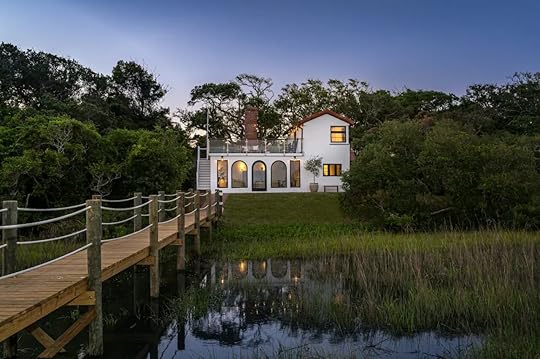 Photo: Airbnb
Photo: Airbnb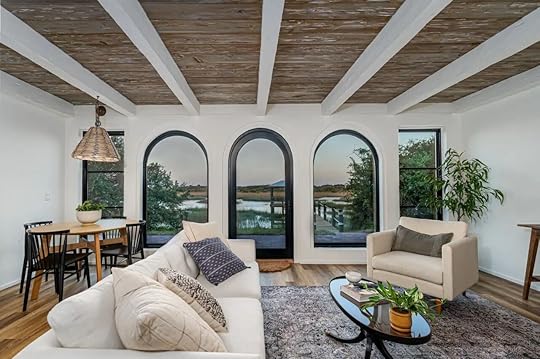 Photo: Airbnb
Photo: Airbnb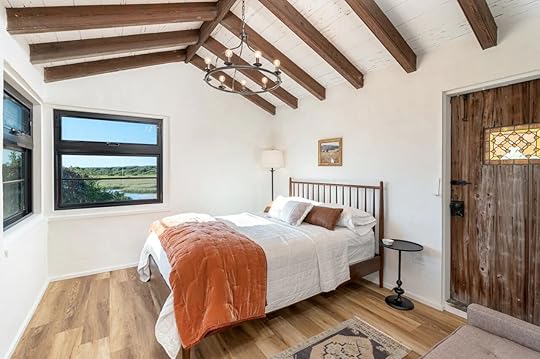 Photo: Airbnb
Photo: Airbnb Photo: Airbnb
Photo: Airbnb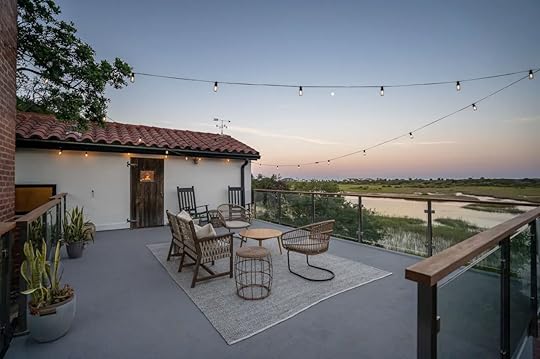 Photo: Airbnb
Photo: AirbnbSee more photos
Check out this one-acre marsh front retreat for your St. Augustine vacation. This newly renovated secluded home features luxury and traditional finishes throughout the house. The home has a rooftop deck, sunrise views of the Atlantic Ocean, downtown, and breathtaking sunsets on the river. Immerse yourself while staying at this secluded home.
Four guests, two bedrooms
Price: $379 per night
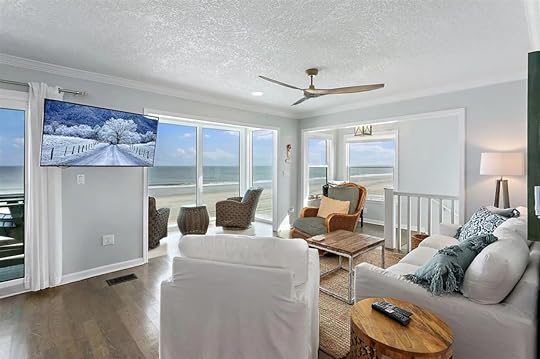 Photo: Airbnb
Photo: Airbnb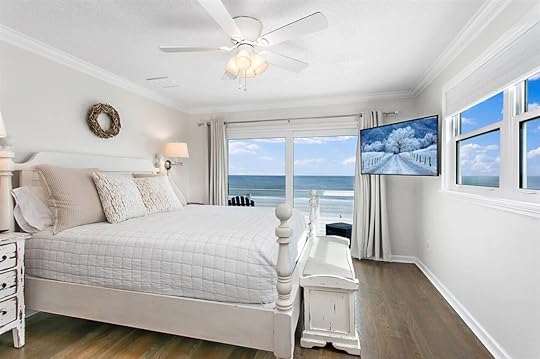 Photo: Airbnb
Photo: Airbnb Photo: Airbnb
Photo: Airbnb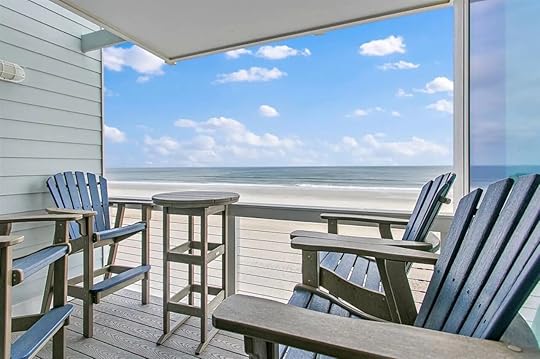 Photo: Airbnb
Photo: Airbnb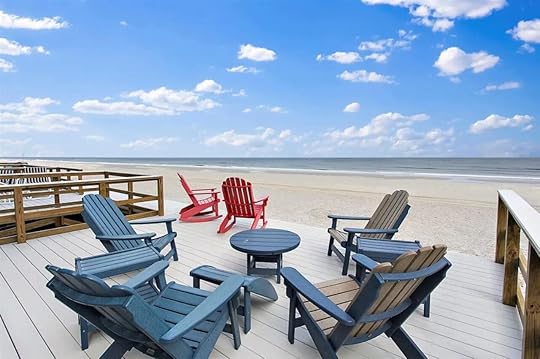 Photo: Airbnb
Photo: AirbnbSee more photos
Relax at this Airbnb St. Augustine beach home and listen to the sounds of the waves crashing on the shore. This modern beachfront townhouse is three stories. The main floor features an elegant kitchen, family room, dining area, half bath, and stunning ocean views. Relax on the main balcony with ocean views.
Six guests, three bedrooms
Price: $412 per night
 Photo: Airbnb
Photo: Airbnb Photo: Airbnb
Photo: Airbnb Photo: Airbnb
Photo: Airbnb Photo: Airbnb
Photo: Airbnb Photo: Airbnb
Photo: AirbnbSee more photos
Stay at this pink escape beach home in St. Augustine. This beach retreat is the perfect home for a family vacation and features a spacious living room, kitchen, and large backyard with games and a pool. The house is three minutes from the beach, and the home has all beach supplies like a beach cart, umbrella, and more. Enjoy the beach or explore downtown, which is only 15 minutes away.
Ten guests, five bedrooms
Price: $198 per night
 Photo: Airbnb
Photo: Airbnb Photo: Airbnb
Photo: Airbnb Photo: Airbnb
Photo: Airbnb Photo: Airbnb
Photo: AirbnbSee more photos
This charming bungalow is perfect for your four-legged travel companions. This restored bungalow features a full kitchen, a bathroom, and a cozy living room area. The cute colorful home has an enclosed patio area and a spacious backyard for you to relax in, and if you want to take advantage of the lovely day, the house also provides guests with two adult bikes and one child’s bike if you’re up for a relaxing ride.

Four guests, two bedrooms
Price: $99 per night
These Are the Best Hotels in Waikiki, Minutes From the Sand, for All Budgets
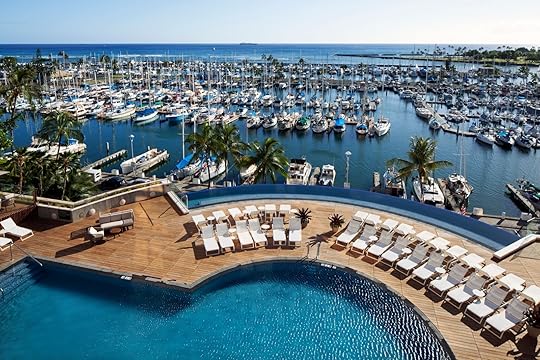
Waikiki is home to one of Hawai’i’s most famous beaches. Renowned for the miles of dazzling coastline, endless shopping and dining opportunities, and postcard-perfect views, Waikiki provides a perfect escape from bustling Honolulu and an oceanfront base to start your vacation in Hawai’i. Regardless of whether you plan to spend all of your time in this convenient location or use it to bookend a trip to the Hawaiian islands, choosing where to stay is paramount. It’s also essential to consider the budget. Hawai’i is famously expensive, and the popularity of Waikiki often means hefty price tags. That said, there are options for all. Here’s a selection of Waikiki hotels, from five-star luxury Hawai’i resorts to more affordable yet top-rated options.
Traveling to Hawai’i? Check out Matador’s guides to the best places to stay on every island:9 of the most breathtaking Airbnbs on MauiThe coolest Airbnbs on O‘ahuThe best Airbnbs on Hawai’i’s Big Island13 stunning yet affordable Airbnbs on KauiThese Hotels on Hawai’i’s Big Island Showcase the State’s Best BeachesWe hope you love the Waikiki hotels we recommend! Just so you know, Matador may collect a small commission from the links on this page if you decide to book a stay.
The Ritz-Carlton Residences Waikiki Beach Photo: Vio
Photo: Vio Photo: Vio
Photo: Vio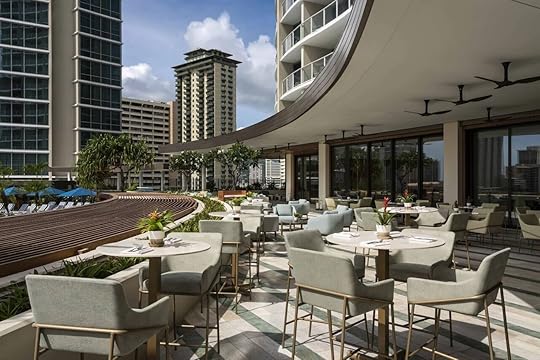 Photo: Vio
Photo: VioThe Ritz-Carlton brings elevated yet casual luxury to Honolulu’s Rodeo Drive. Located a couple of blocks from Waikiki Beach, the hotel offers guests proximity yet a peaceful location away from the busyness of Waikiki. Its excellent position on O‘ahu means you can drive to any point on the island within a little over an hour. The hotel dates back to the early 1900s, originally built as a beachfront estate. Since then, it has been transformed into one of Hawai’i’s most iconic luxury hotels.
There are 552 stylishly appointed guest rooms and suites in two towers, all of which are ocean-facing. The accommodations range from studios to multi-bedroom residences with gourmet kitchens, spacious living areas, and private balconies or terraces with breathtaking views of the Pacific Ocean. Guests can also enjoy luxurious amenities such as coffee shops, a fitness center, spa services, an outdoor infinity pool with a deck peppered with cabanas and daybeds, restaurants offering local cuisine and international flavors, shopping boutiques, live entertainment venues, and more.
The Ritz-Carlton Residences Waikiki Beach: 383 Kalaimoku Street, Waikiki Beach, Honolulu, HI, 96815
Book NowAston Waikiki Beach Tower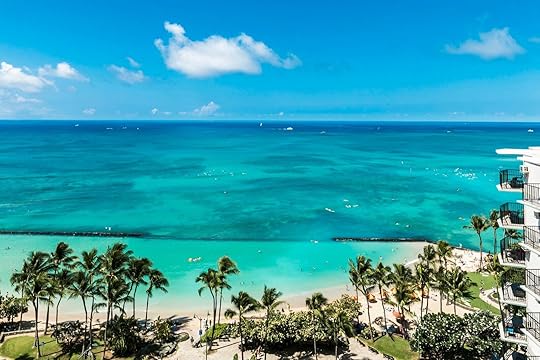 Photo: Aqua-Aston Hospitality
Photo: Aqua-Aston Hospitality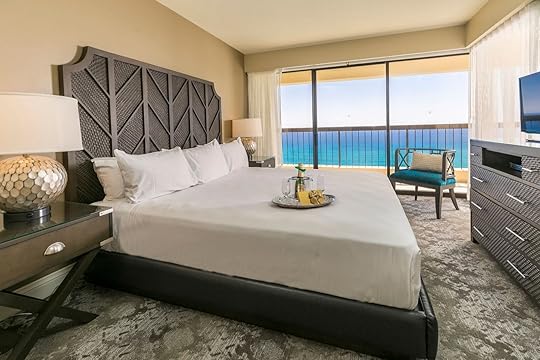 Photo: Aqua-Aston Hospitality
Photo: Aqua-Aston Hospitality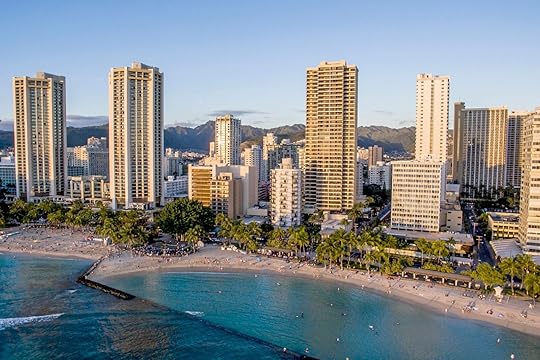 Photo: Aqua-Aston Hospitality
Photo: Aqua-Aston HospitalityAston Waikiki Beach Hotel is a luxurious, family-friendly hotel directly across from Waikiki’s Kuhio Beach. Kuhio Beach has plenty of activities, such as swimming, surfing, snorkeling, and kayaking, making this a superb option for those needing to entertain kids. The hotel’s location is unbeatable, but the oceanfront property offers guests an unforgettable experience with its enormous ocean-front pool, sea-view tiki bar-inspired restaurant, and modern architecture and design features. There are 645 air-conditioned rooms with surf-inspired decor ranging from standard rooms to spacious and elegantly furnished one and two-bedroom suites. If you’re looking for something with a central location and excellent facilities, especially for a group, Aston Waikiki Beach delivers.
Aston Waikiki Beach Hotel: 2470 Kalakaua Ave, Honolulu, HI, 96815
Book NowThe Royal Hawaiian, a Luxury Collection Resort, Waikiki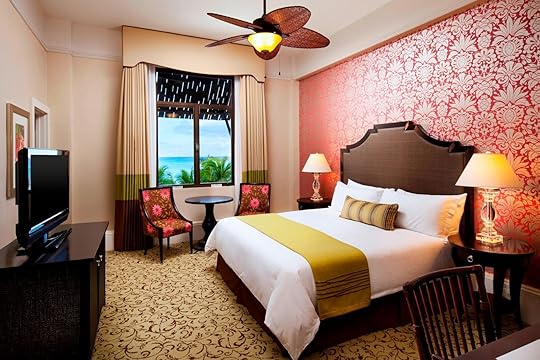 Photo: Vio.com
Photo: Vio.com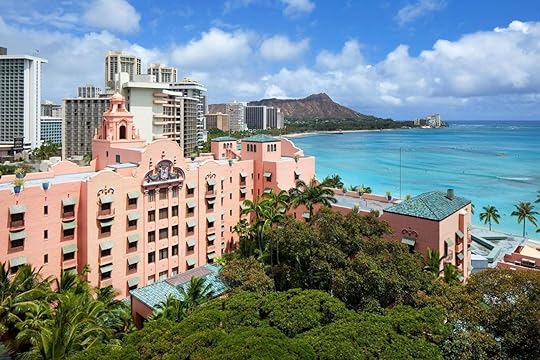 Photo: Vio.com
Photo: Vio.com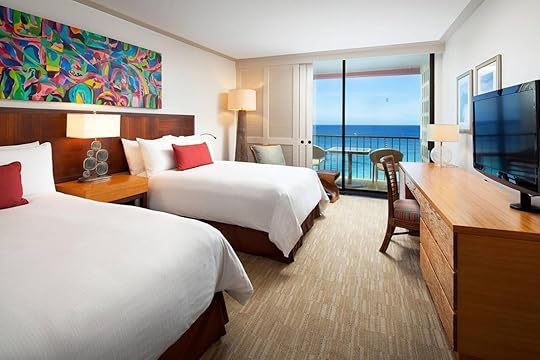 Photo: Vio.com
Photo: Vio.comThe Royal Hawaiian has been a landmark on the Waikiki strip for 90 years. Set between the high rises of the Sheraton and Outrigger Waikiki, it’s famed for its signature pink facade and lush tropical gardens. The hotel is also popular due to its many resort-like amenities, including a full-service spa, fitness center, beach cabanas and umbrellas, restaurants serving local cuisine, and activities for kids of all ages. It is another ideal destination hotel for families. Surf lessons, stand-up paddleboard rentals, and special events are hosted within the resort premises. Guests can also access the shared seaside pool with a water slide at the nearby Sheraton Waikiki.
The Royal Hawaiian: 2259 Kalakaua Avenue, Honolulu, HI, 96815
Book NowPrince Waikiki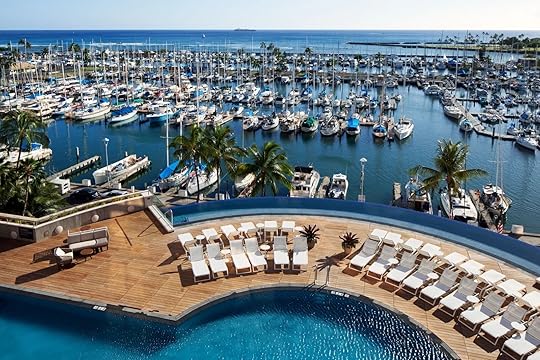 Photo: Vio.com
Photo: Vio.com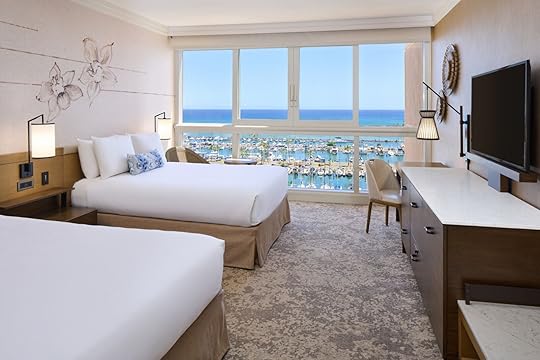 Photo: Vio.com
Photo: Vio.com Photo: Vio.com
Photo: Vio.comThe Prince Waikiki is Honolulu’s answer for the business traveler. It’s centrally positioned and provides an exceptional backdrop for a dinner meeting or drink by the pool after a conference. Located on the waterfront of Ala Wai Yacht Harbor, this upscale hotel offers breathtaking views of the ocean and the city’s glittering skyline. The hotel has 521 rooms and suites designed with floor-to-ceiling windows to take advantage of the stunning views. This is the best option for on-the-go travelers who need convenience, outstanding dining, and harbor views.
Prince Waikiki: 100 Holomoana St, Honolulu, HI, 96815
Book NowAston at the Waikiki Banyan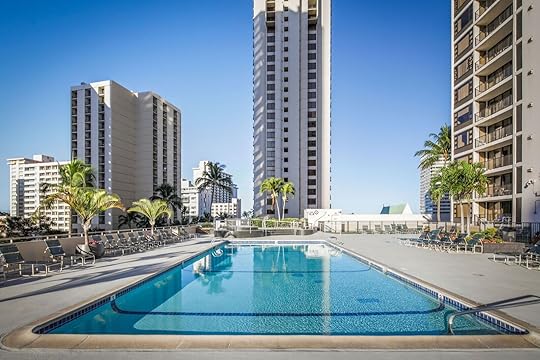 Photo: Aqua-Aston Hospitality
Photo: Aqua-Aston Hospitality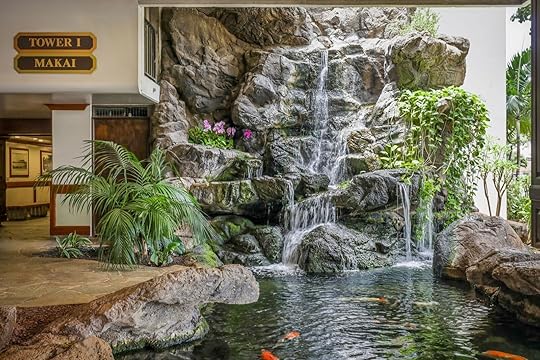 Photo: Aqua-Aston Hospitality
Photo: Aqua-Aston Hospitality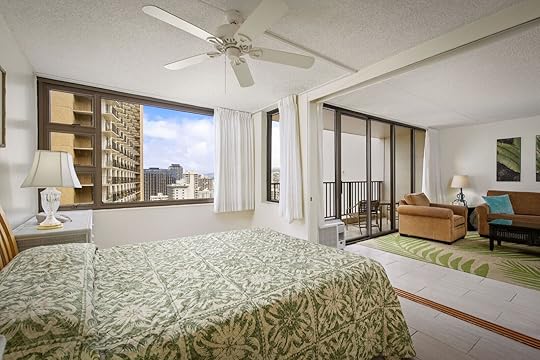 Photo: Aqua-Aston Hospitality
Photo: Aqua-Aston HospitalitySee more photos
Aston at the Waikiki Banyan is a condo-style hotel catering to travelers seeking affordability and amenities in a convenient location. The hotel is popular with return visitors who adore its prime Waikiki position and suite-like setup. It offers large living areas and full kitchens equipped with appliances and cookware, which is ideal for those traveling with children. Guests can enjoy the swimming pool area, tennis courts, and communal grilling facilities when not at the beach, which is minutes away.
Aston at the Waikiki Banyan: 201 ʻŌhua Ave, Honolulu, HI 96815
Book NowVive Hotel Waikiki Photo: Vio.com
Photo: Vio.com Photo: Vio.com
Photo: Vio.com Photo: Vio.com
Photo: Vio.comThe Vive is a mid-range chain hotel five minutes walk from Waikiki Beach. The hotel offers an authentic island experience with its modern design and friendly Hawaiian hospitality. It is strategically located in a prime location near shops, restaurants, and other nearby attractions, such as the Diamond Head State Monument and Honolulu Zoo. There are 119 modern and sleek rooms, some with ocean views. A complimentary breakfast buffet of homemade pastries and fresh fruit is served in the open lobby, and guests can borrow beach chairs, boogie boards, and umbrellas from reception. There is no pool, but the proximity to the beach makes up for this. If you are a solo traveler or digital nomad looking to meet people but want something more elevated than a hostel, Vive is a superb option. There are also often discounts if you stay for more than seven nights.
Vive Hotel Waikiki: 2426 Kuhio Avenue, Honolulu, HI, 96815
Book NowAqua Palms Waikiki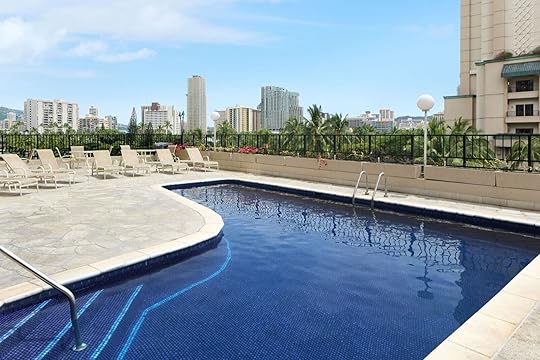 Photo: Aqua-Aston Hospitality
Photo: Aqua-Aston Hospitality Photo: Aqua-Aston Hospitality
Photo: Aqua-Aston Hospitality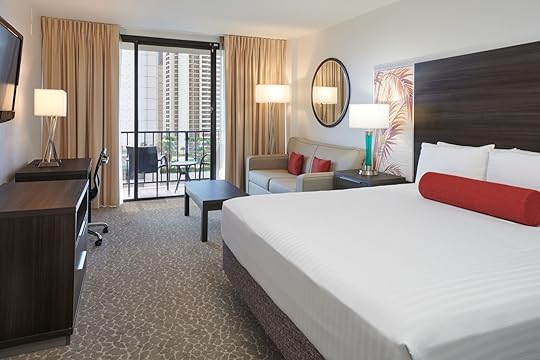 Photo: Aqua-Aston Hospitality
Photo: Aqua-Aston HospitalitySee more photos
Aqua Palms Waikiki is a recently renovated boutique hotel just a block from the main beach. It offers a more intimate experience with friendly, service-oriented staff than nearby large chain resorts. The location is ideal for those who want to be close to Waikiki but not directly on the busy strip. Duke Kahanamoku Lagoon, a popular spot for swimming and paddling, is within walking distance, along with Fort DeRussy Park, a beachfront park offering stunning views and historical sites. Guest rooms, deluxe studio suites, and one-bedroom suites were updated in 2020 and feature splashes of tropical décor.
Aqua Palms Waikiki: 1850 Ala Moana Blvd, Honolulu, HI 96815
Book NowLuana Waikiki Hotel & Suites Photo: Vio.com
Photo: Vio.com Photo: Vio.com
Photo: Vio.com Photo: Vio.com
Photo: Vio.comLuana Waikiki sits adjacent to Fort DeRussy Park and is just a short stroll away from Waikiki Beach. This is another terrific hotel for families and is a more affordable option if your budget is a consideration. The hotel features studios and suites with kitchenettes and breathtaking views of Honolulu’s skyline or the Pacific Ocean from the private patio or lanais. There’s also a great range of amenities, such as a heated swimming pool with a sundeck and barbecue grills and a newly renovated fitness center. Because the hotel is not in the center, it offers the best of both worlds. It’s close enough to the action but in a peaceful and safe location.
Luana Waikiki Hotel & Suites: 2045 Kalakaua Ave., Honolulu, HI, 96815
Book NowShoreline Hotel Waikiki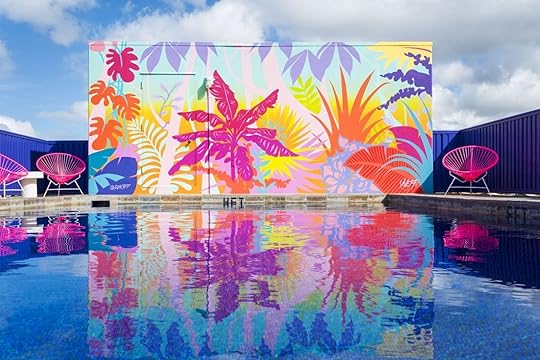 Photo: Vio.com
Photo: Vio.com Photo: Vio.com
Photo: Vio.com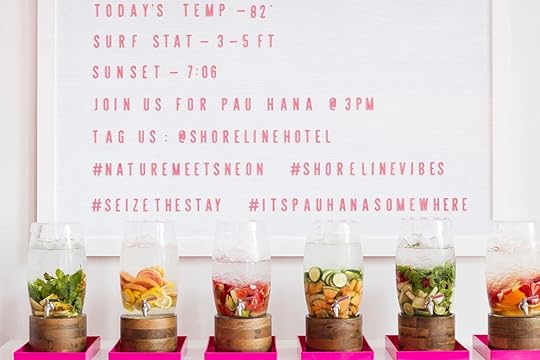 Photo: Vio.com
Photo: Vio.comSituated just a block away from the beach on Seaside Avenue, this boutique hotel offers 135 rooms over 14 floors and is known for its colorful lobby and comfy rooms. The design features are unique and eye-catching; from the brightly colored accent walls to the paper mache birds, retro decor, and art déco paintings — it’s easy to see why Shoreline Hotel Waikiki is such a popular mid-range hotel. There’s also a funky and equally colorful outdoor rooftop pool where you can take a dip or relax on the sun deck chairs while admiring views over the city.
Shoreline Hotel Waikiki: 342 Seaside Ave, Honolulu, HI, 96815
Book NowAqua Skyline at Island Colony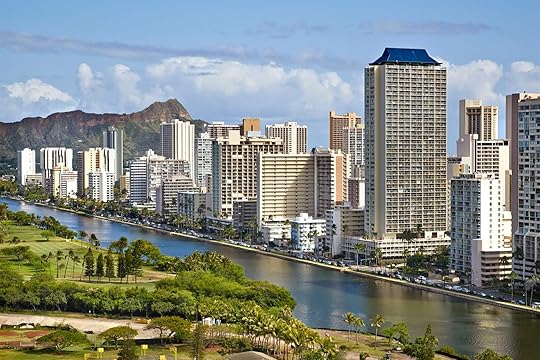 Photo: Aqua-Aston Hospitality
Photo: Aqua-Aston Hospitality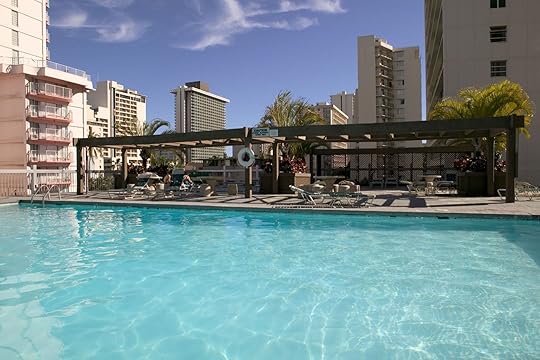 Photo: Aqua-Aston Hospitality
Photo: Aqua-Aston Hospitality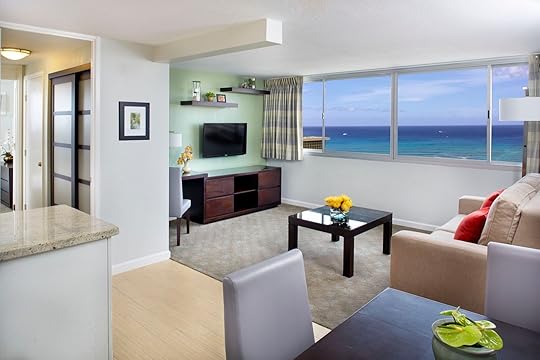 Photo: Aqua-Aston Hospitality
Photo: Aqua-Aston HospitalitySee more photos
This 44-story high-rise hotel is Waikiki’s tallest building, offering guests panoramic views of the area. It sits just two blocks from Waikiki Beach, putting the white sand and turquoise waters within easy walking distance. Honolulu’s world-class shopping, dining, and nightlife are at your doorstep. Modern three-star accommodations range in size from studios to one-bedrooms with kitchenettes. All have walk-out balconies, many offering views of the Pacific Ocean and Ko’olau Mountains.
Aqua Skyline at Island Colony: 445 Seaside Ave Ste 3C, Honolulu, HI 96815
Book NowCoconut Waikiki Hotel Photo: Vio.com
Photo: Vio.com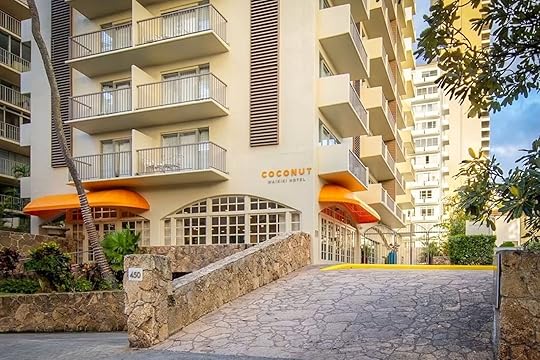 Photo: Vio.com
Photo: Vio.com Photo: Vio.com
Photo: Vio.comThis family-friendly boutique hotel is a lovely alternative for a group amid the large chain hotels in Waikiki. The tagline, “You’re family now,” is evident in the hotel’s guest reviews that rave about the friendliness of staff and local vibe of the small yet facility-packed property. It is in a quiet canal-side location, a 10-minute walk from Waikiki Beach and three blocks from the main drag. The 81 rooms and suites are bright and colorful with pops of yellow, small kitchenettes, and furnished lanais with city or mountain views. There’s a great range of facilities, including a heated outdoor pool, fitness center, a grilling area, and games for kids.
Coconut Waikiki Hotel: 450 Lewers Street, Honolulu, HI, 96815
Book NowWhat part of Waikiki is best?The best neighborhoods for beach vacations are Waikiki, Ala Moana, Diamond Head, and Kahala. Waikiki offers the busiest beaches with the most activities and amenities, like hotels and restaurants. The area around Fort Derussy Beach is great for families looking for a quieter beach experience. For those who want to be close to the action but still have some peace and quiet, Queen’s Surf or Kuhio Beach are great options.
What is the pink hotel in Waikiki?The pink hotel in Waikiki is the Royal Hawaiian Resort. It’s in prime position on the Waikiki strip and got its name due to its iconic pink walls.
Which hotels in Waikiki have no resort fees?There are several hotels in Waikiki that offer no resort fees, so you can enjoy your stay without worrying about extra costs. The best way to understand the rates of each property is to contact the hotel directly. 
Matador Network's Blog
- Matador Network's profile
- 6 followers



